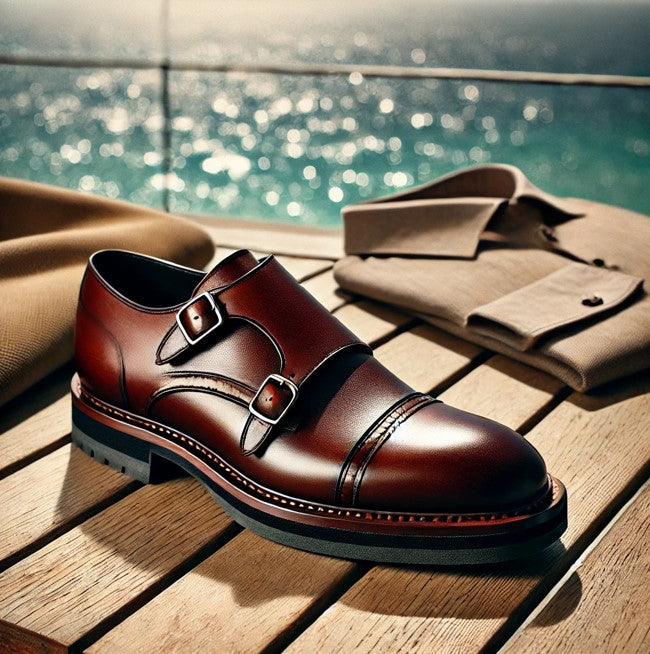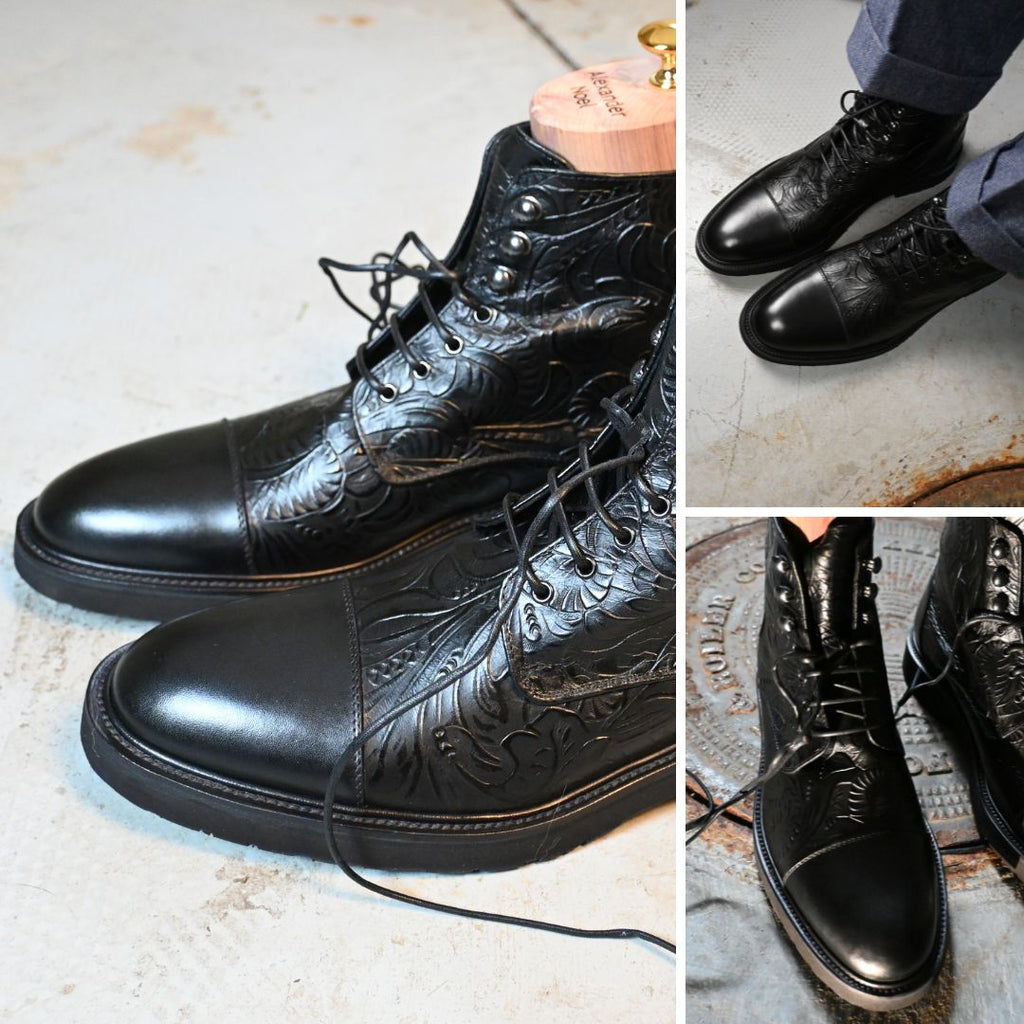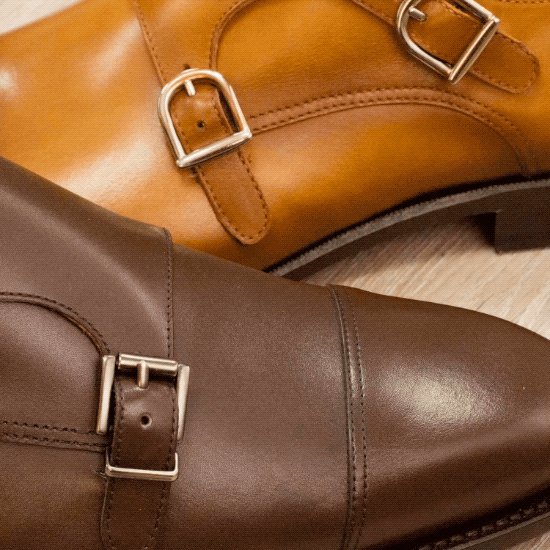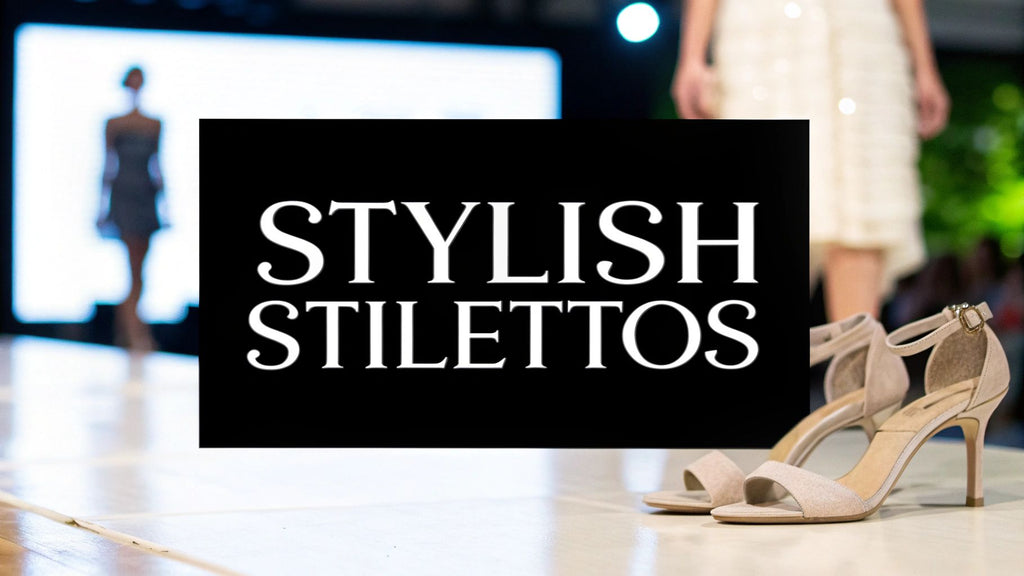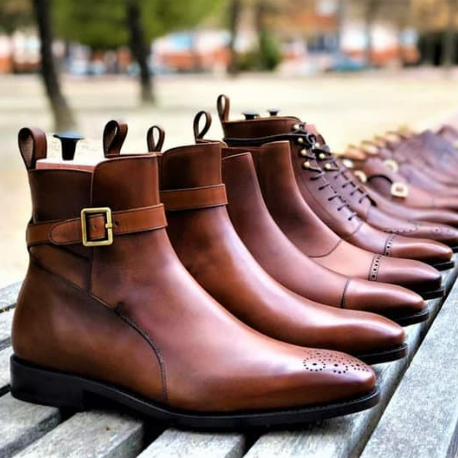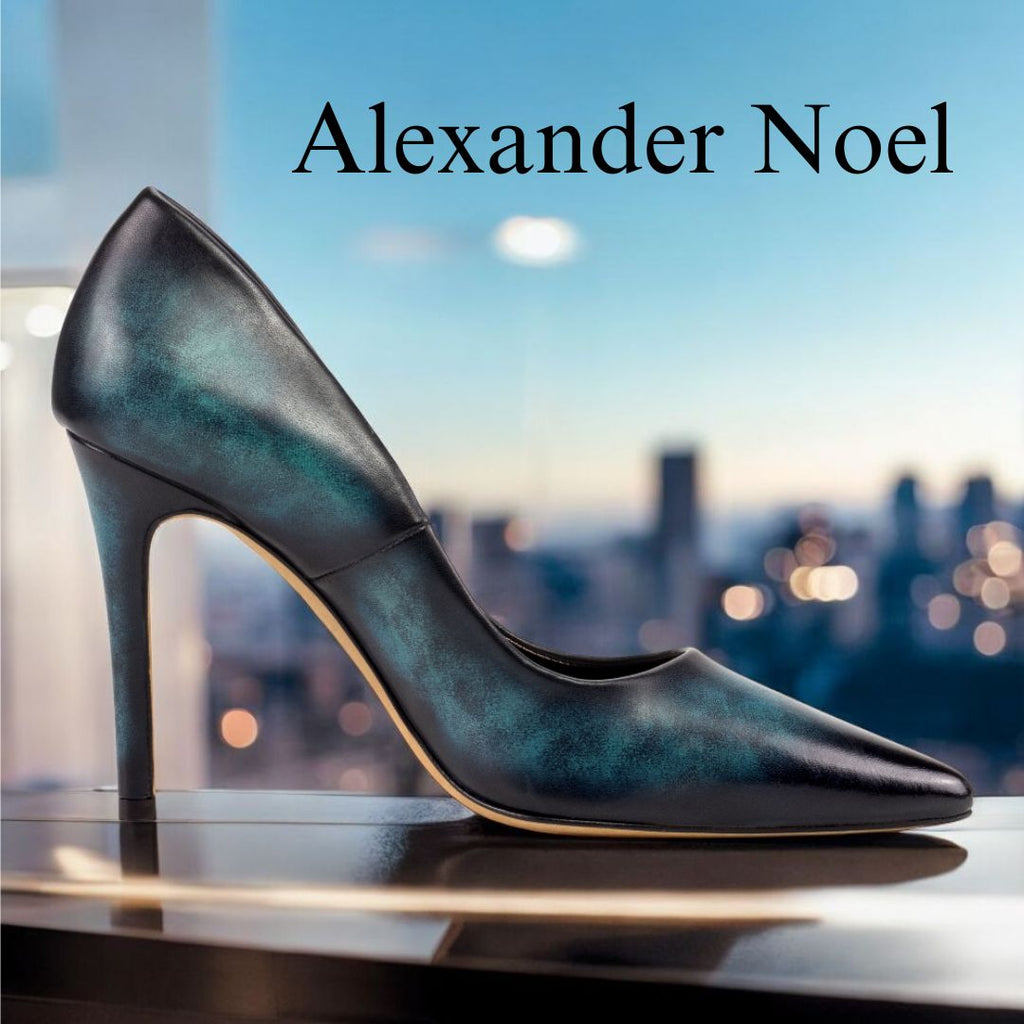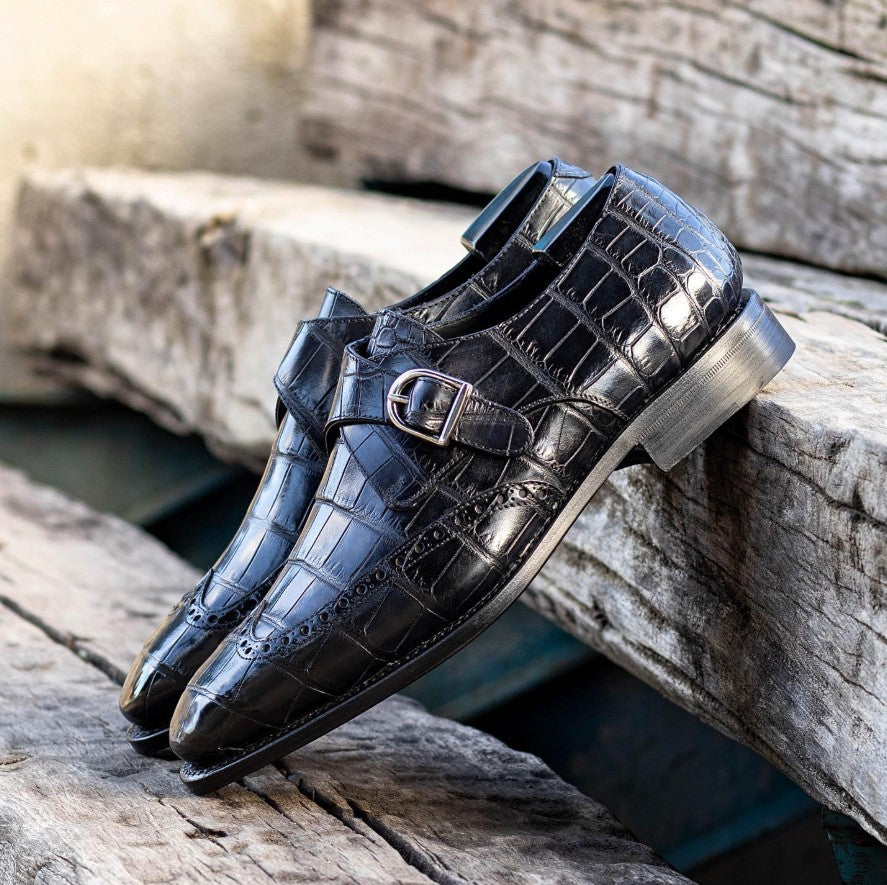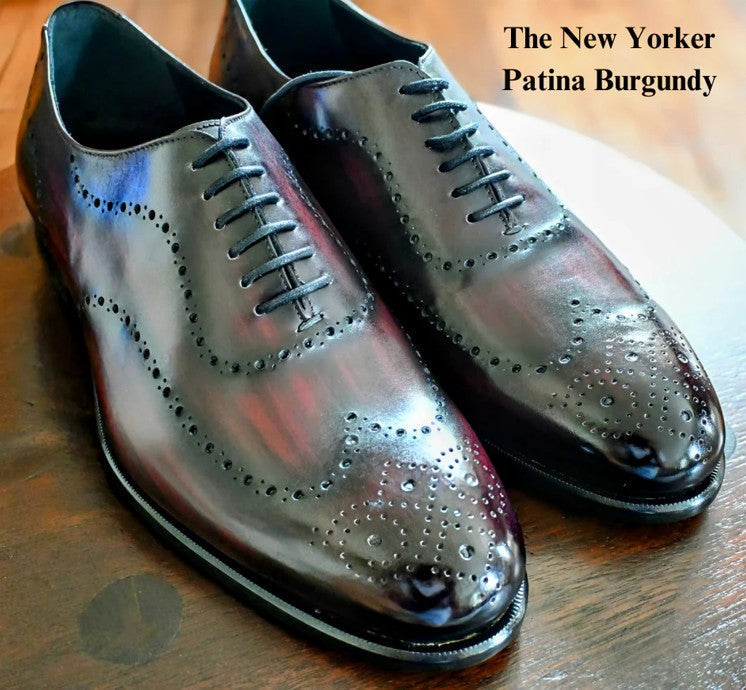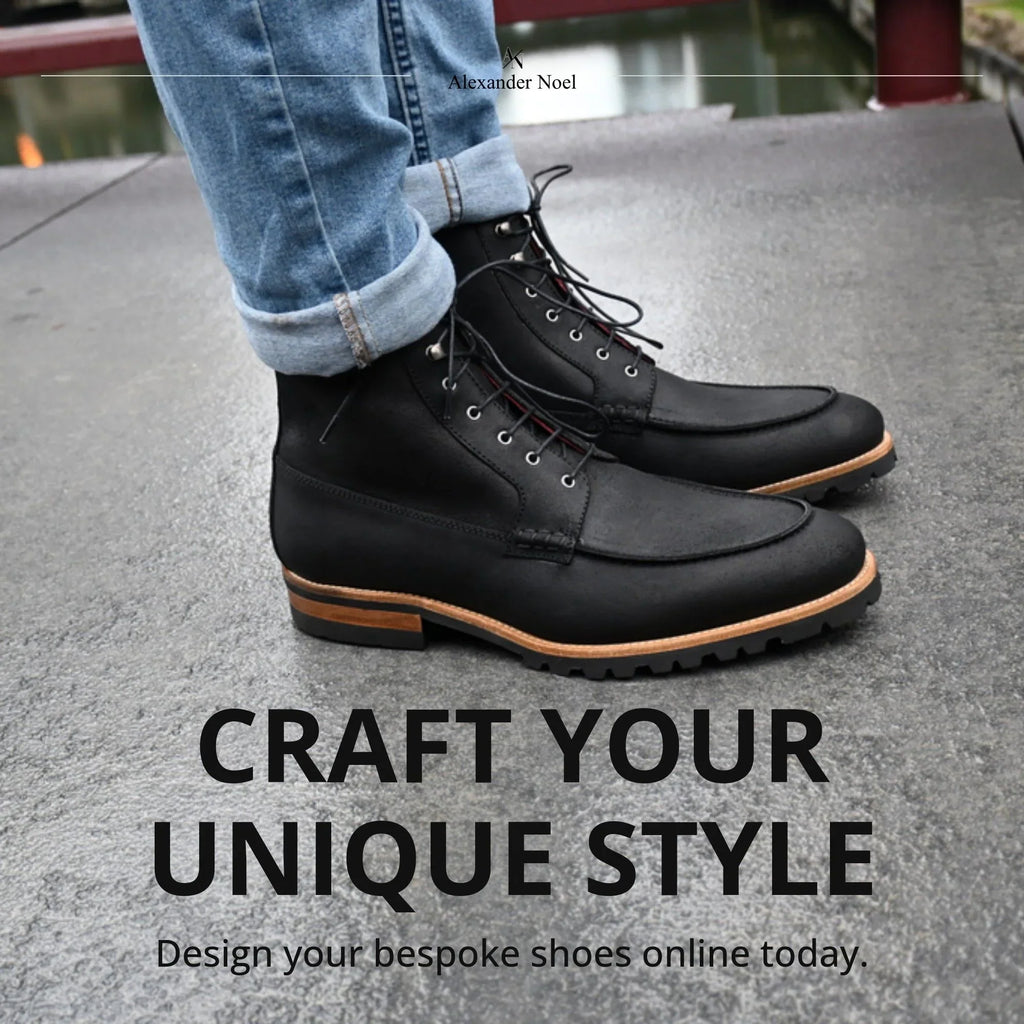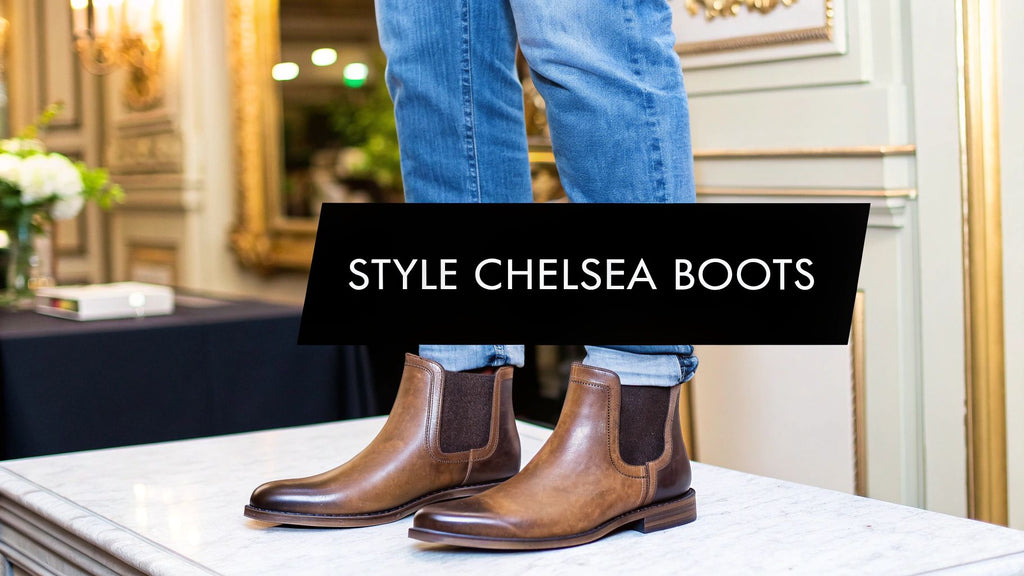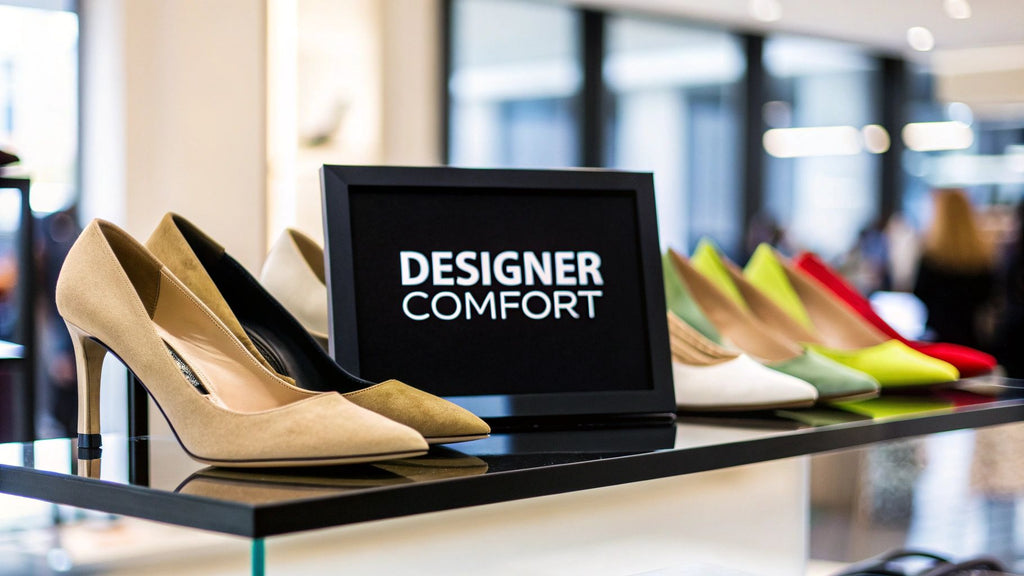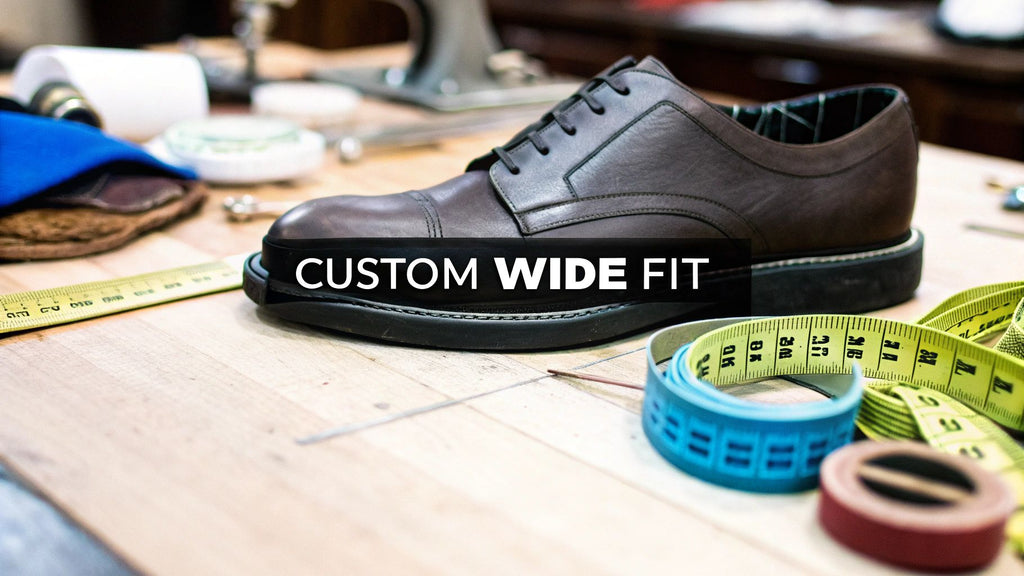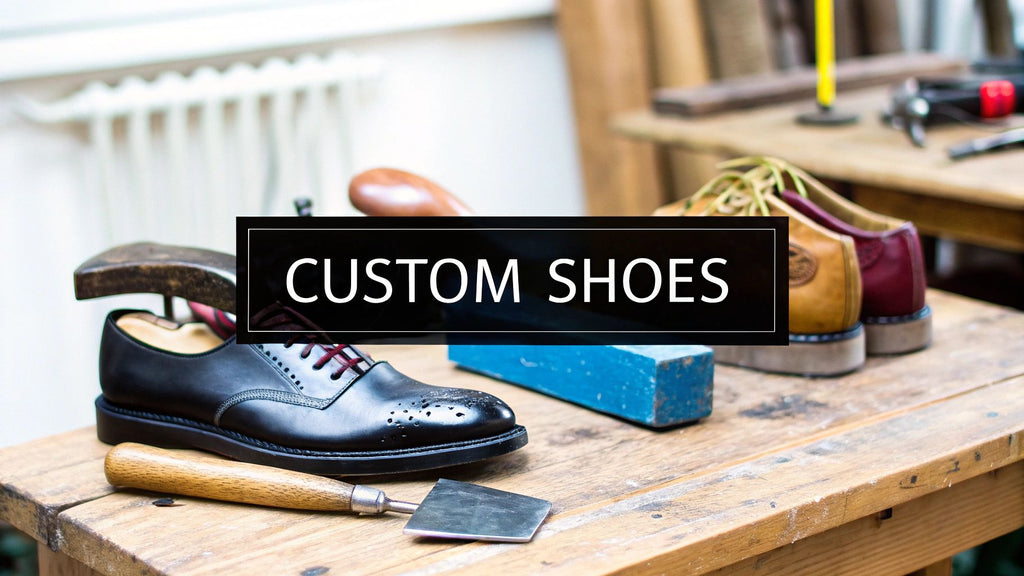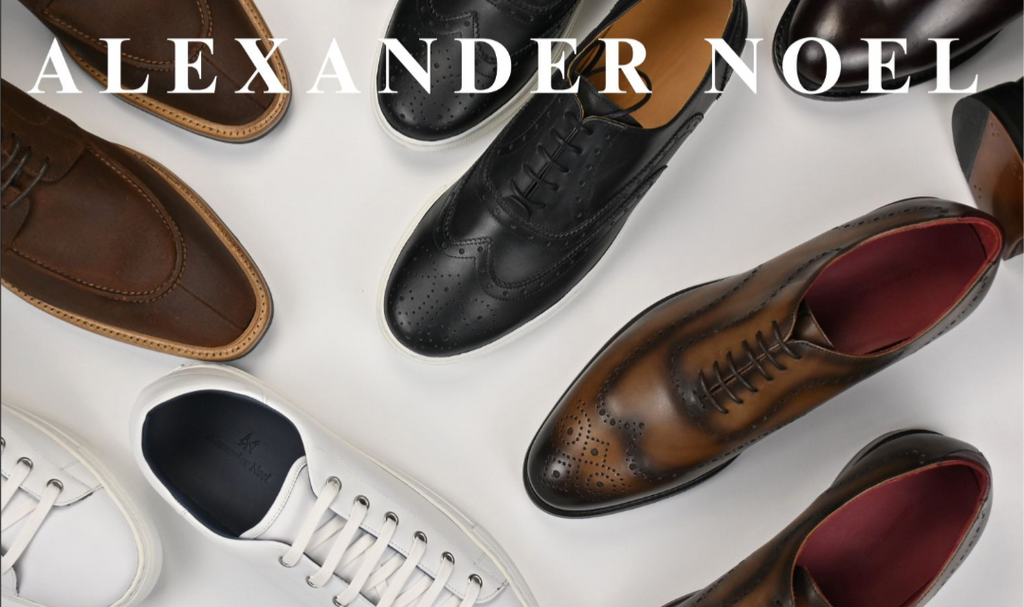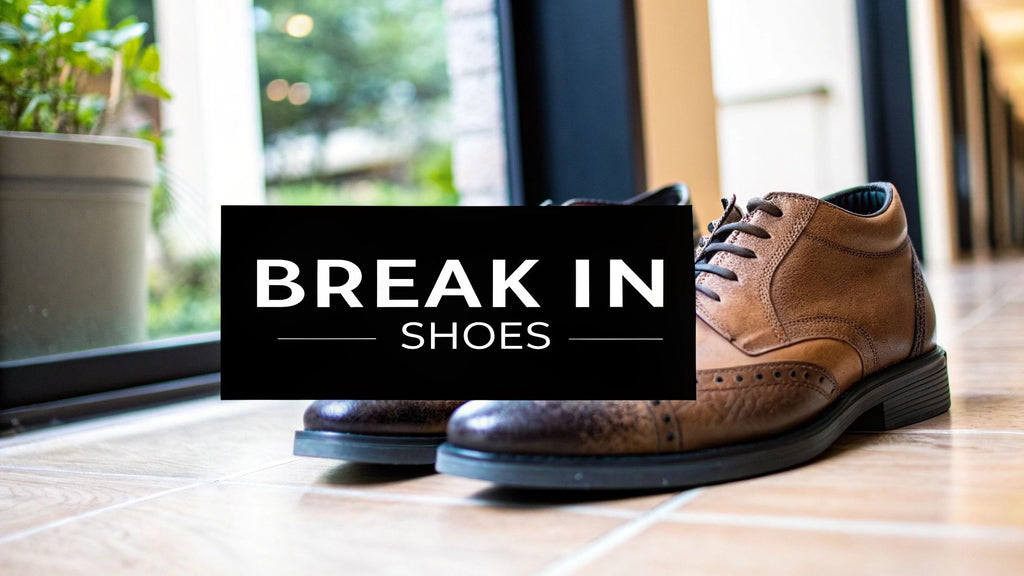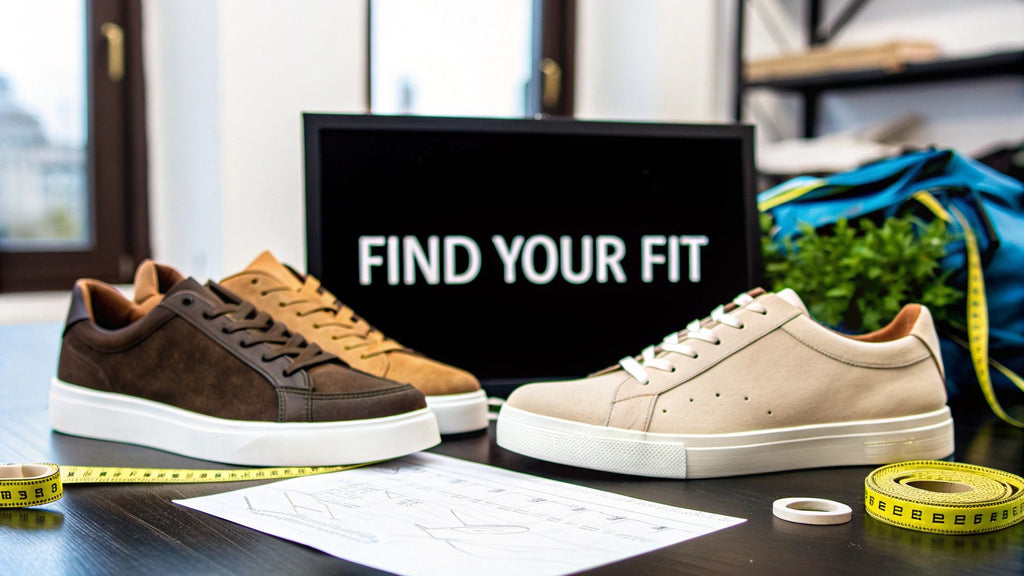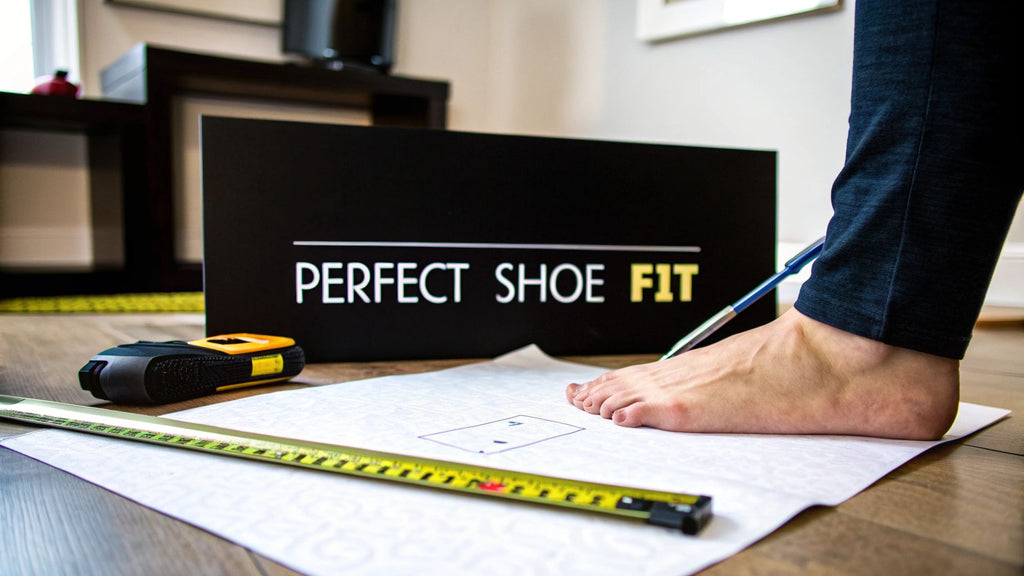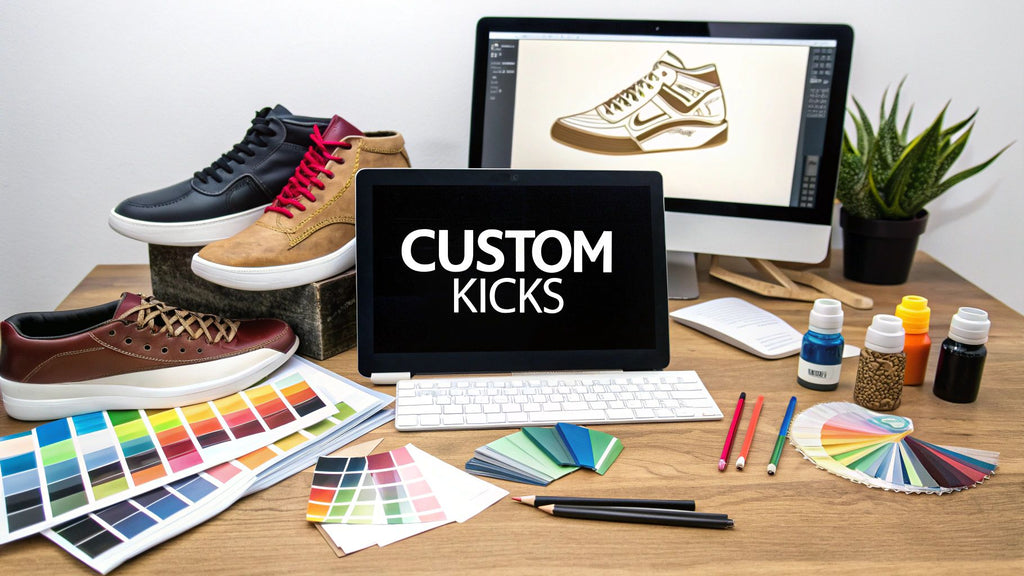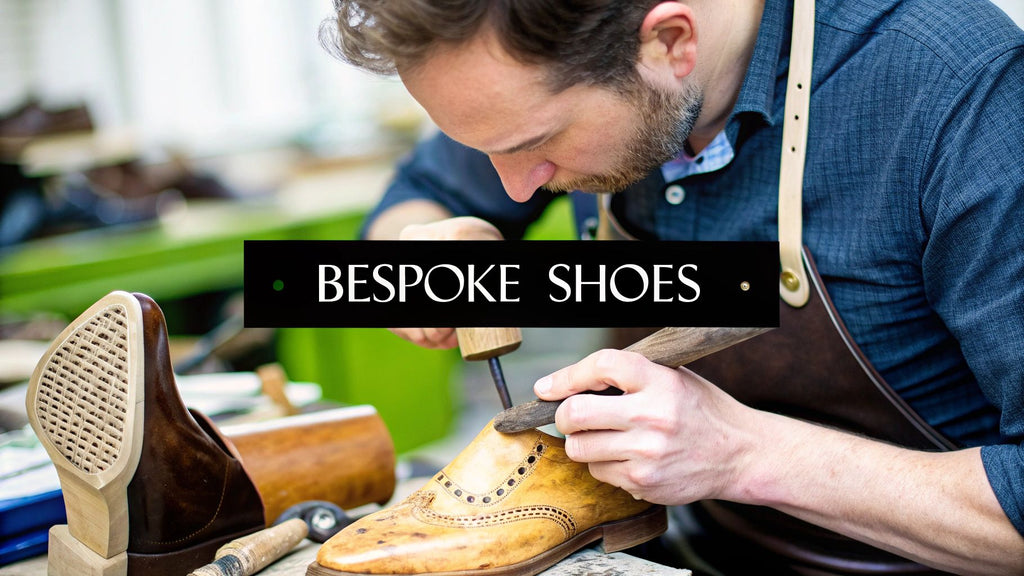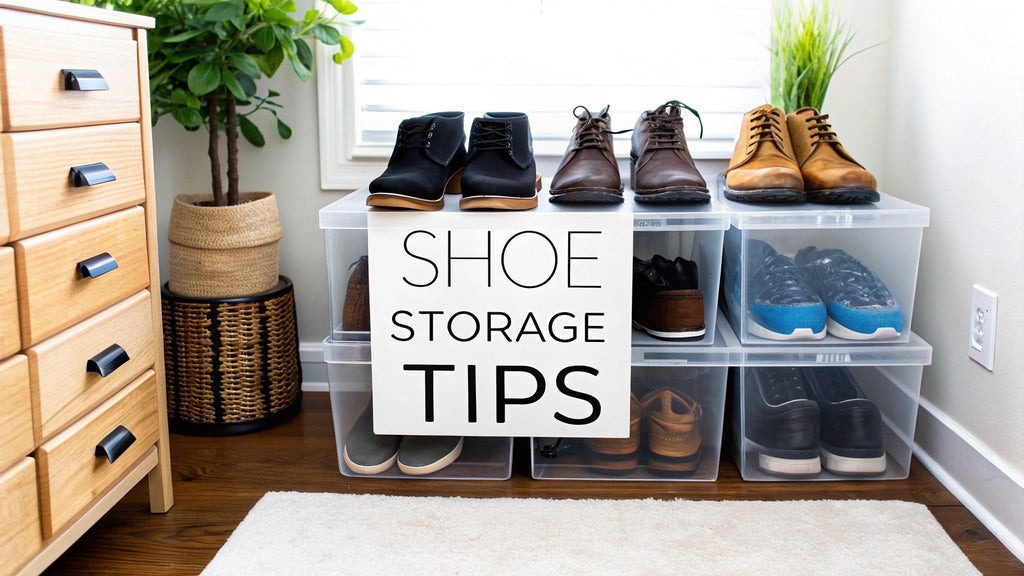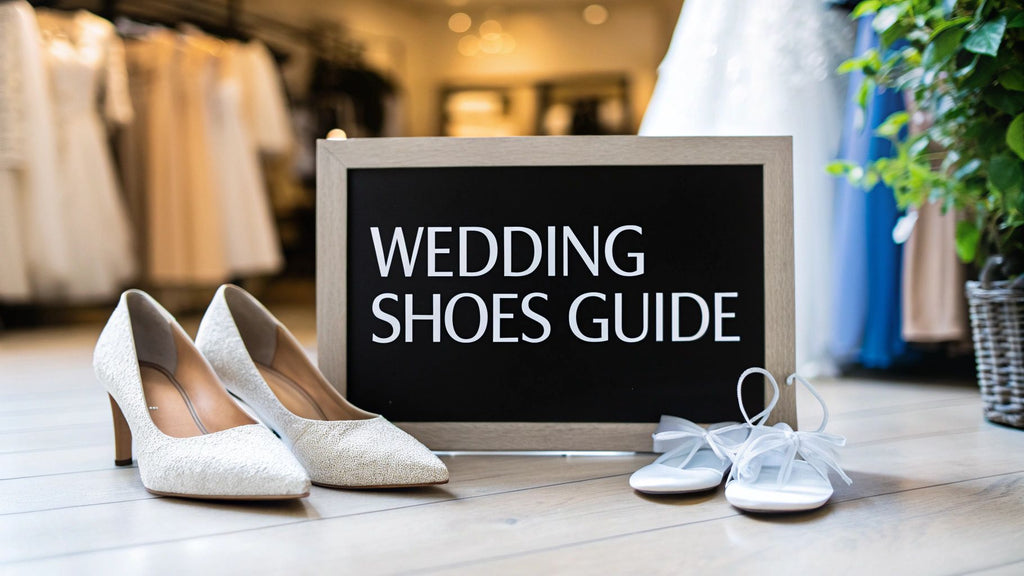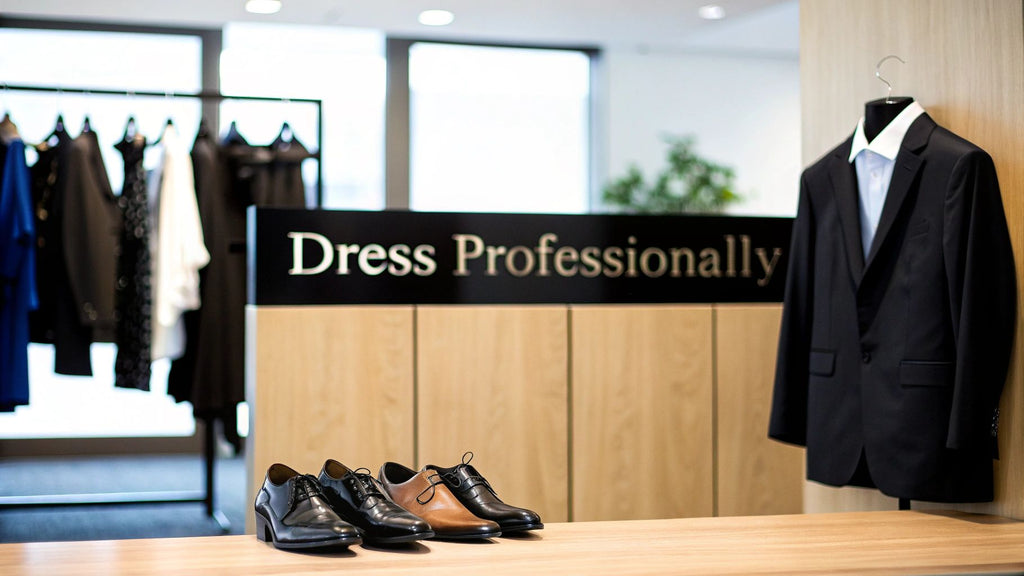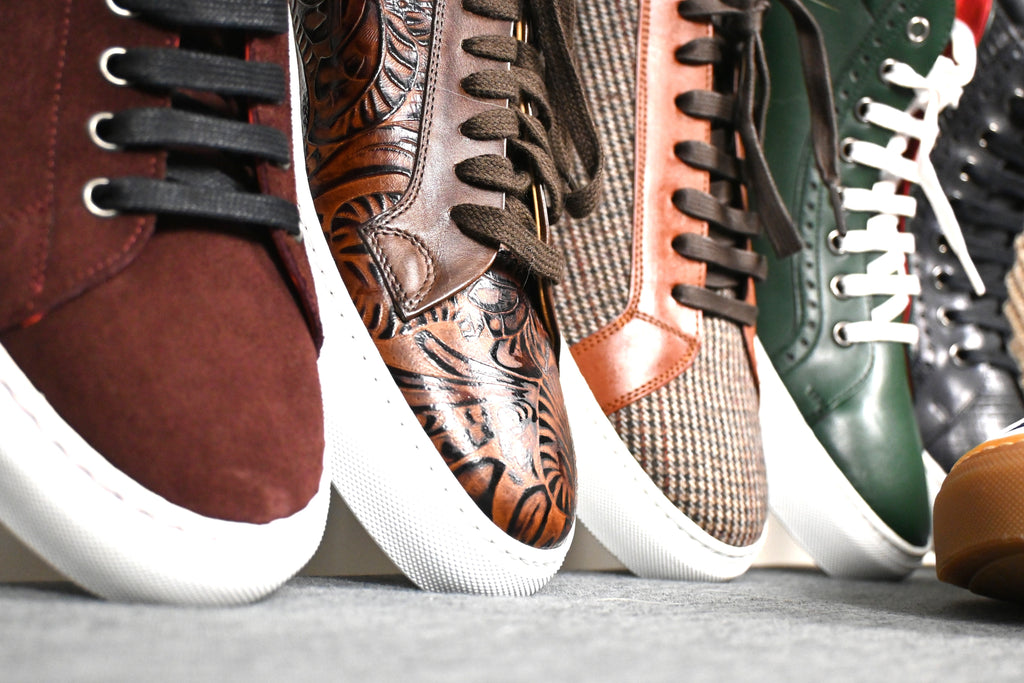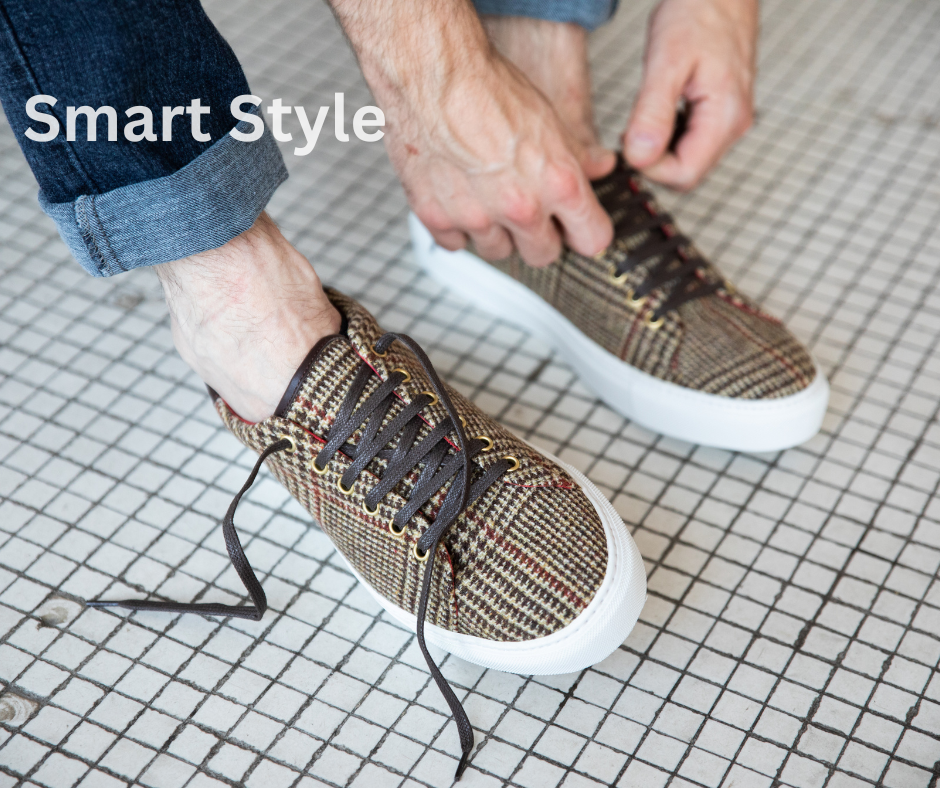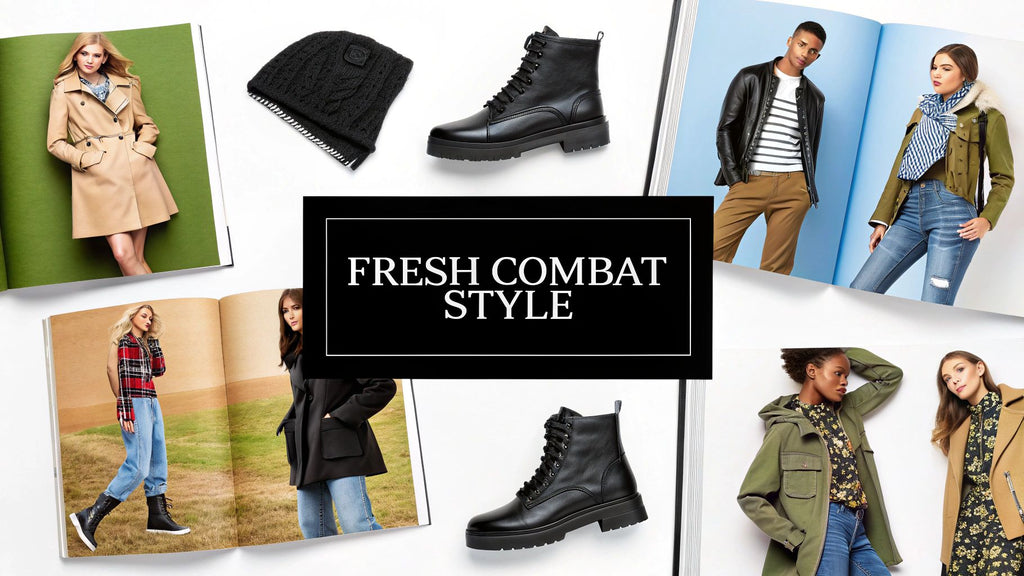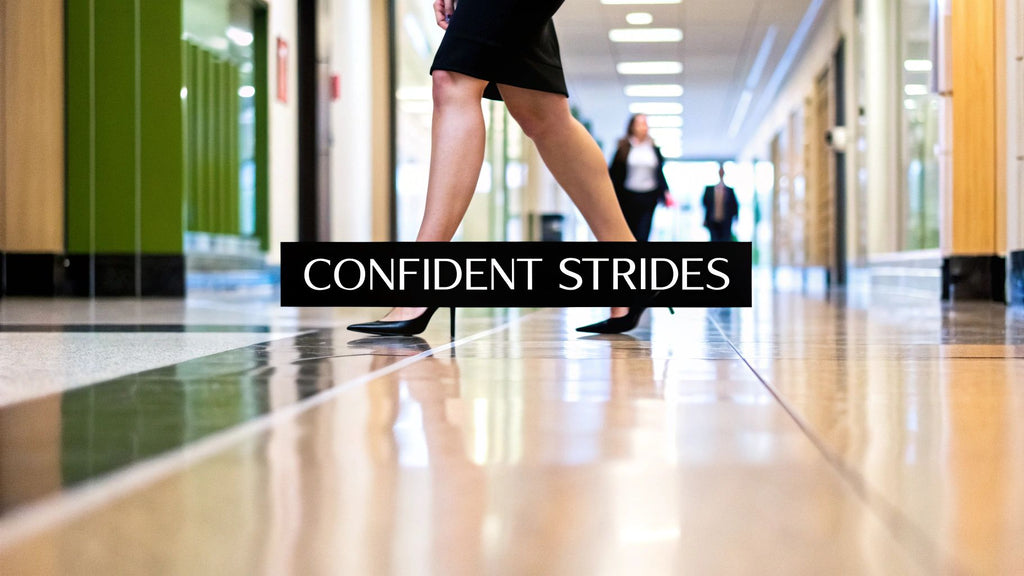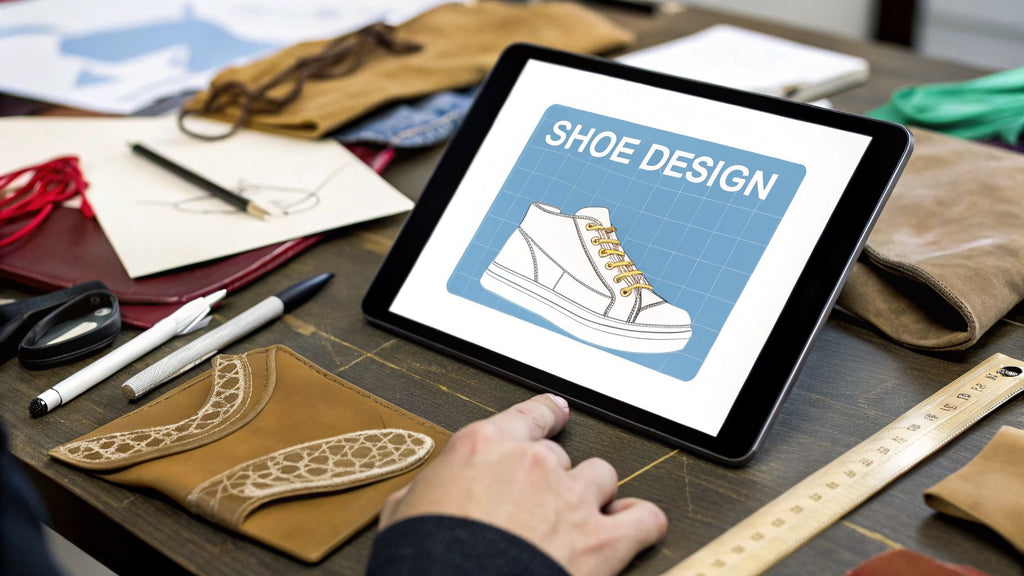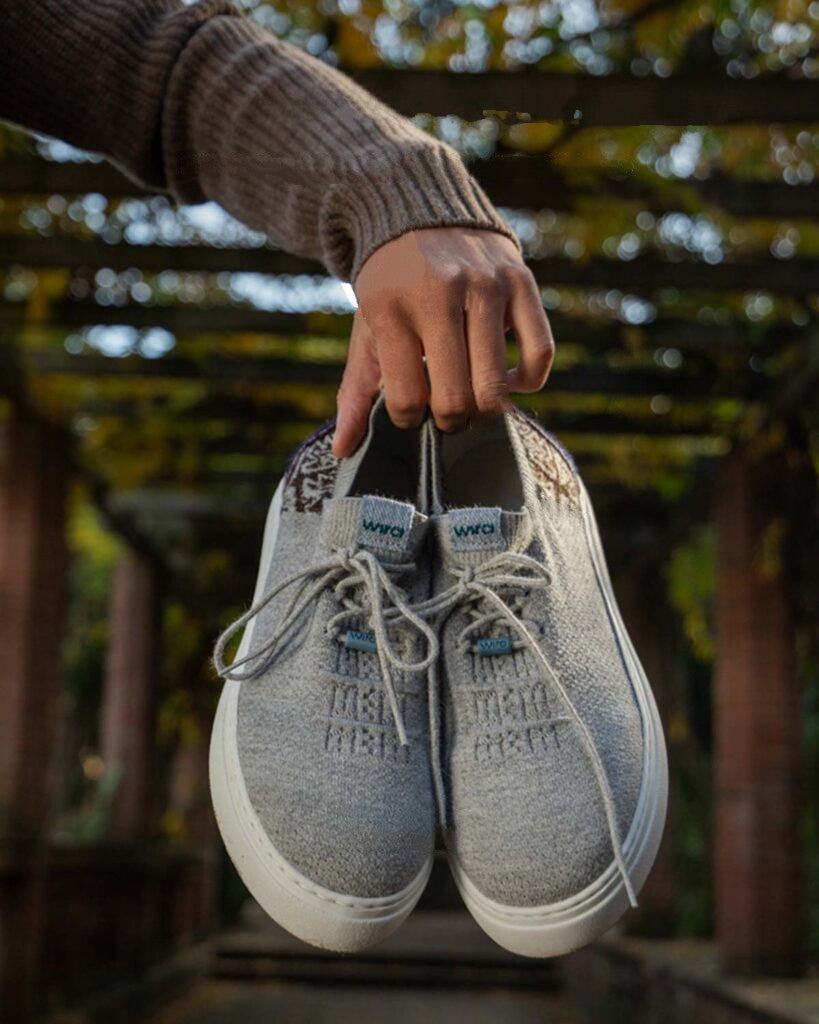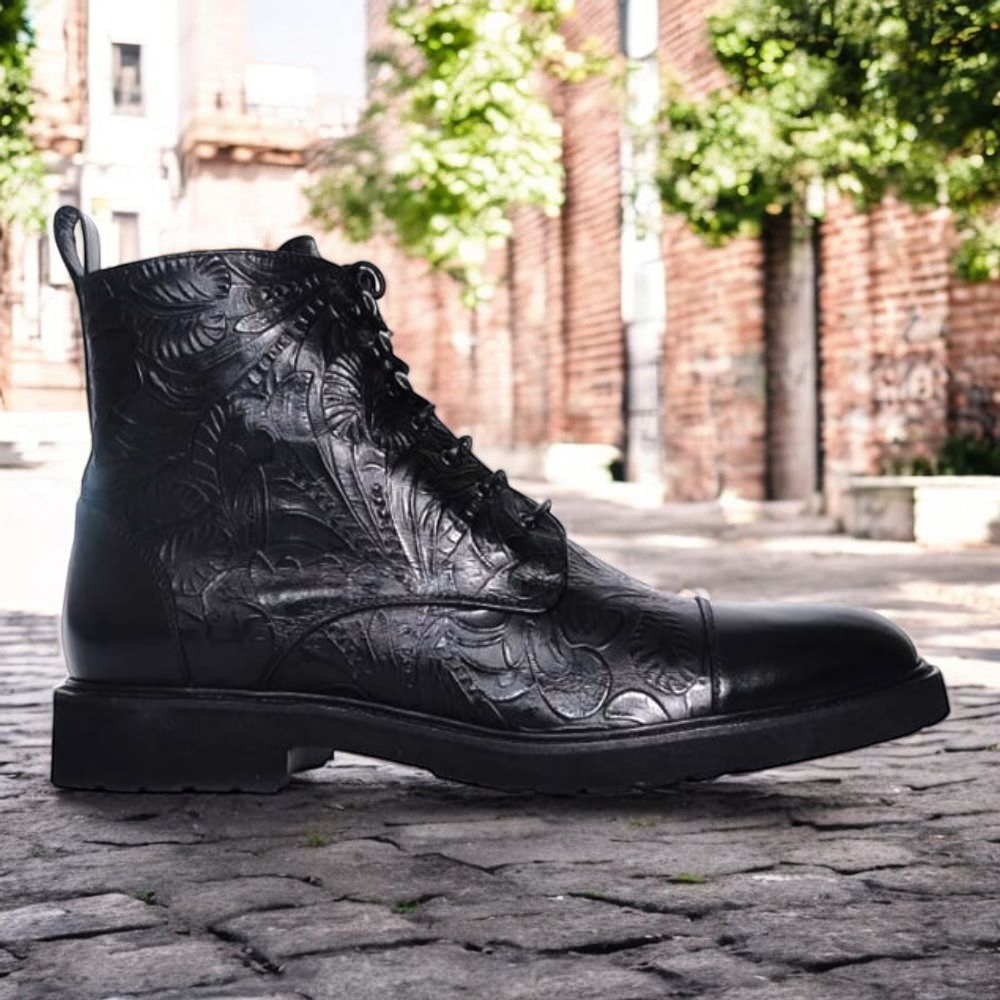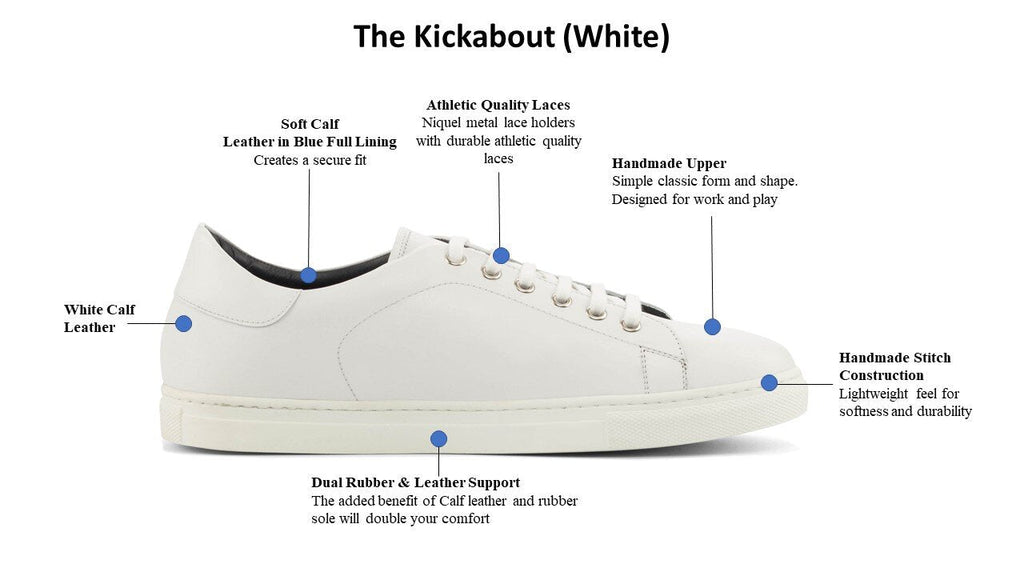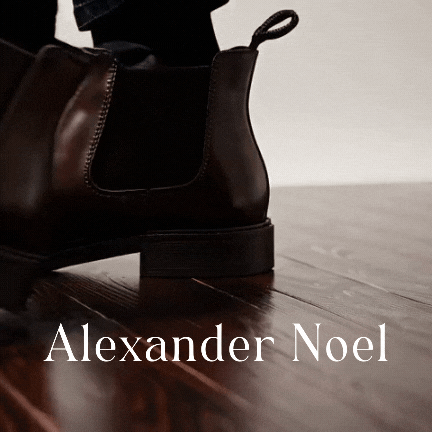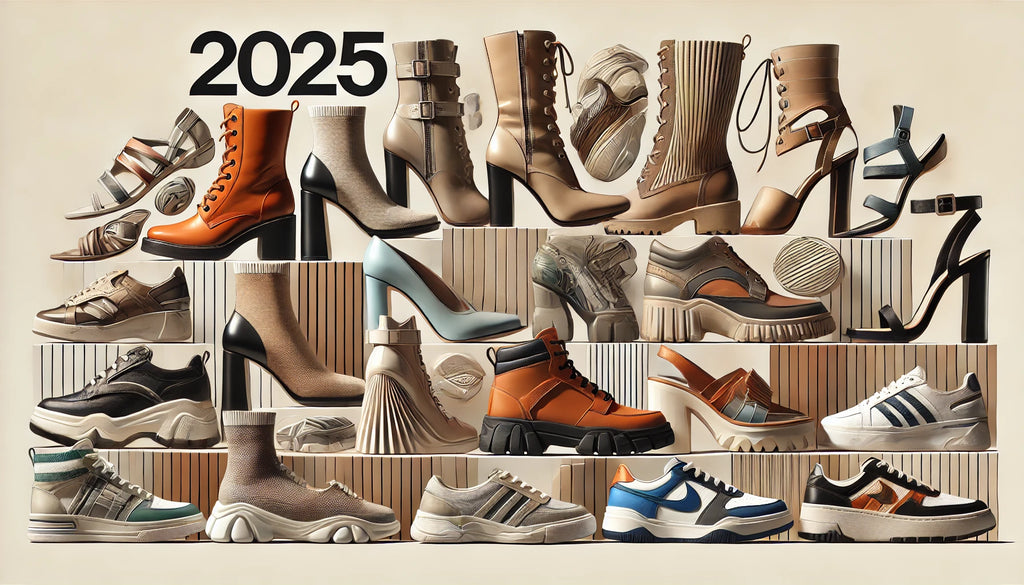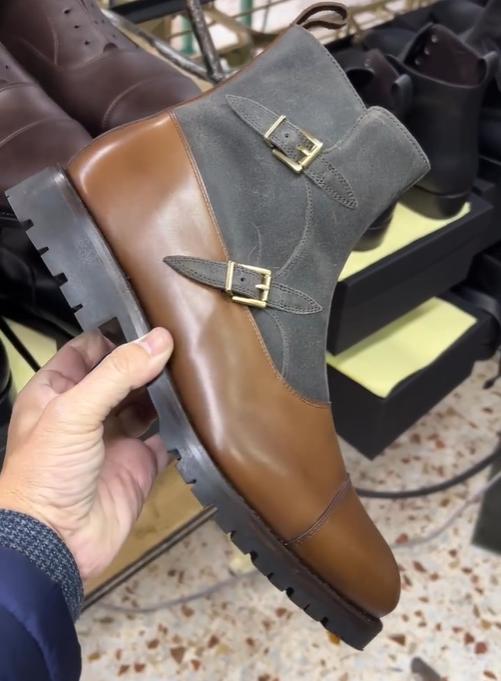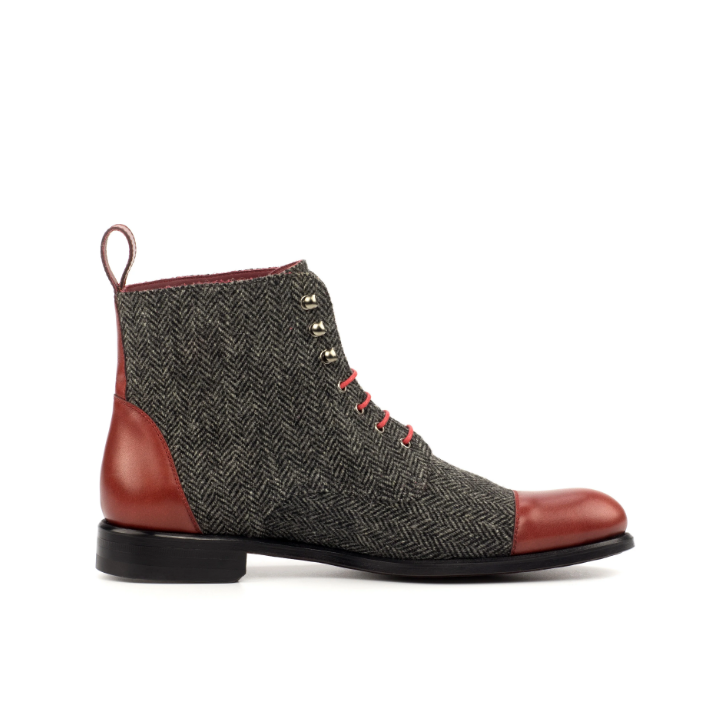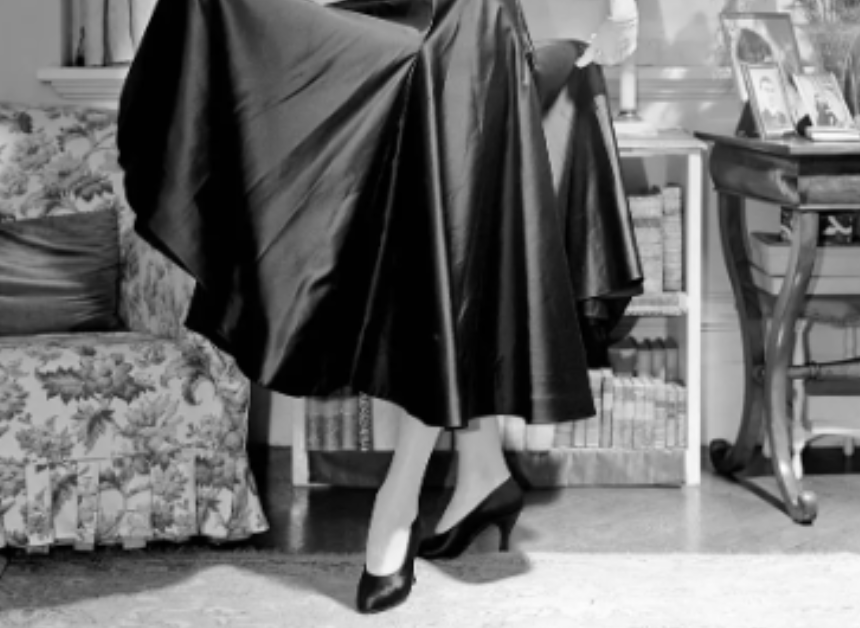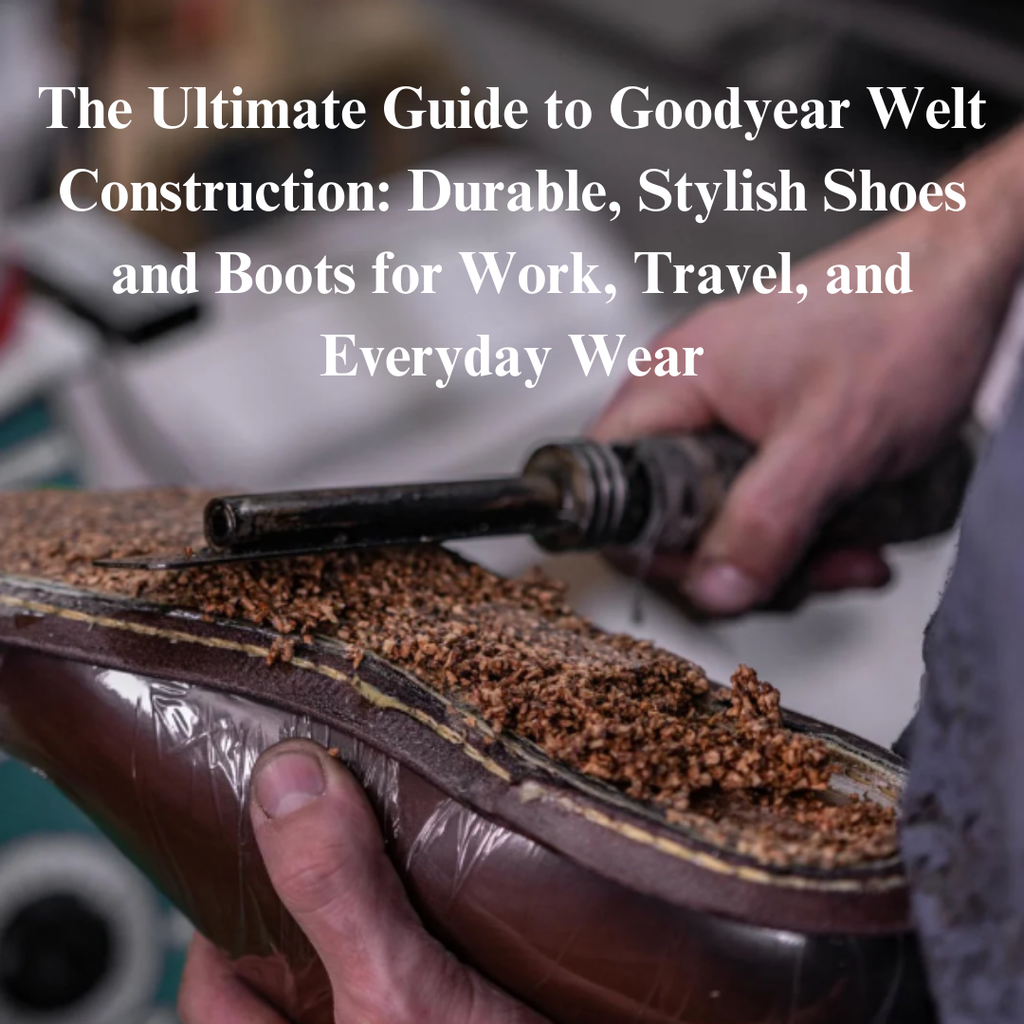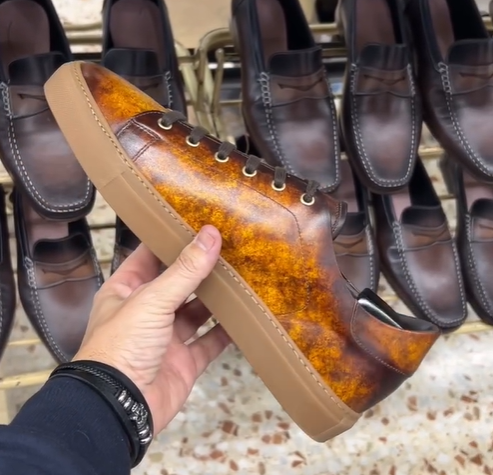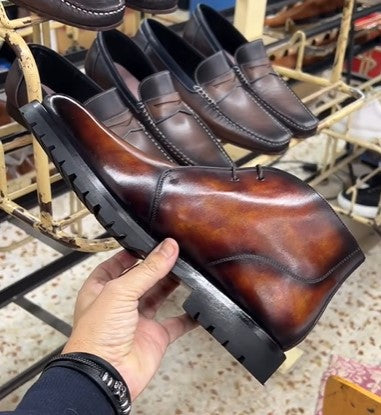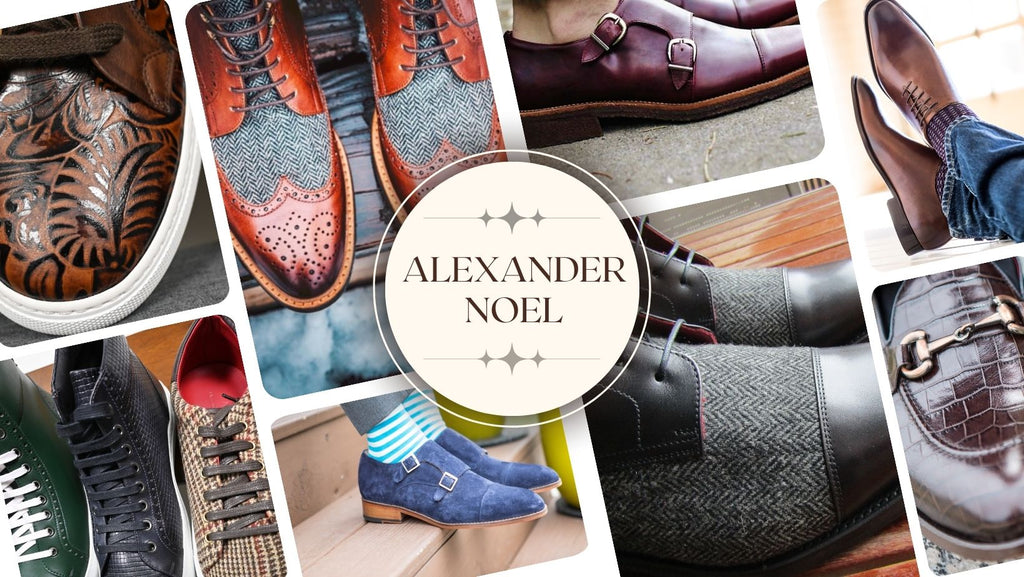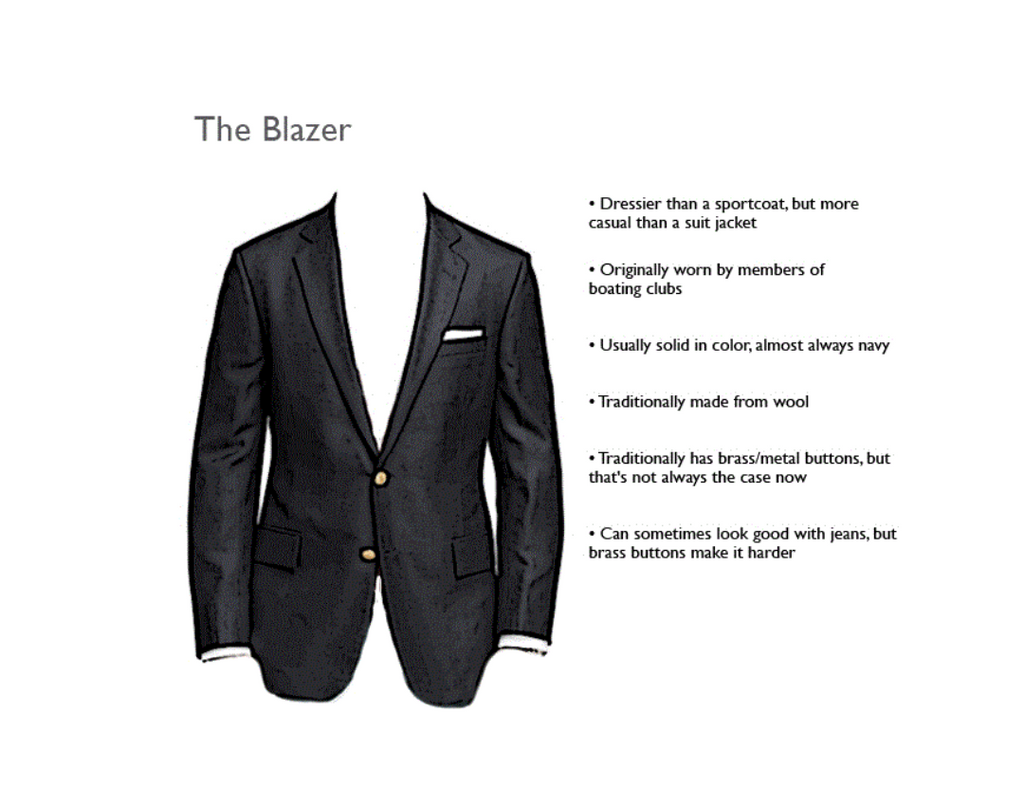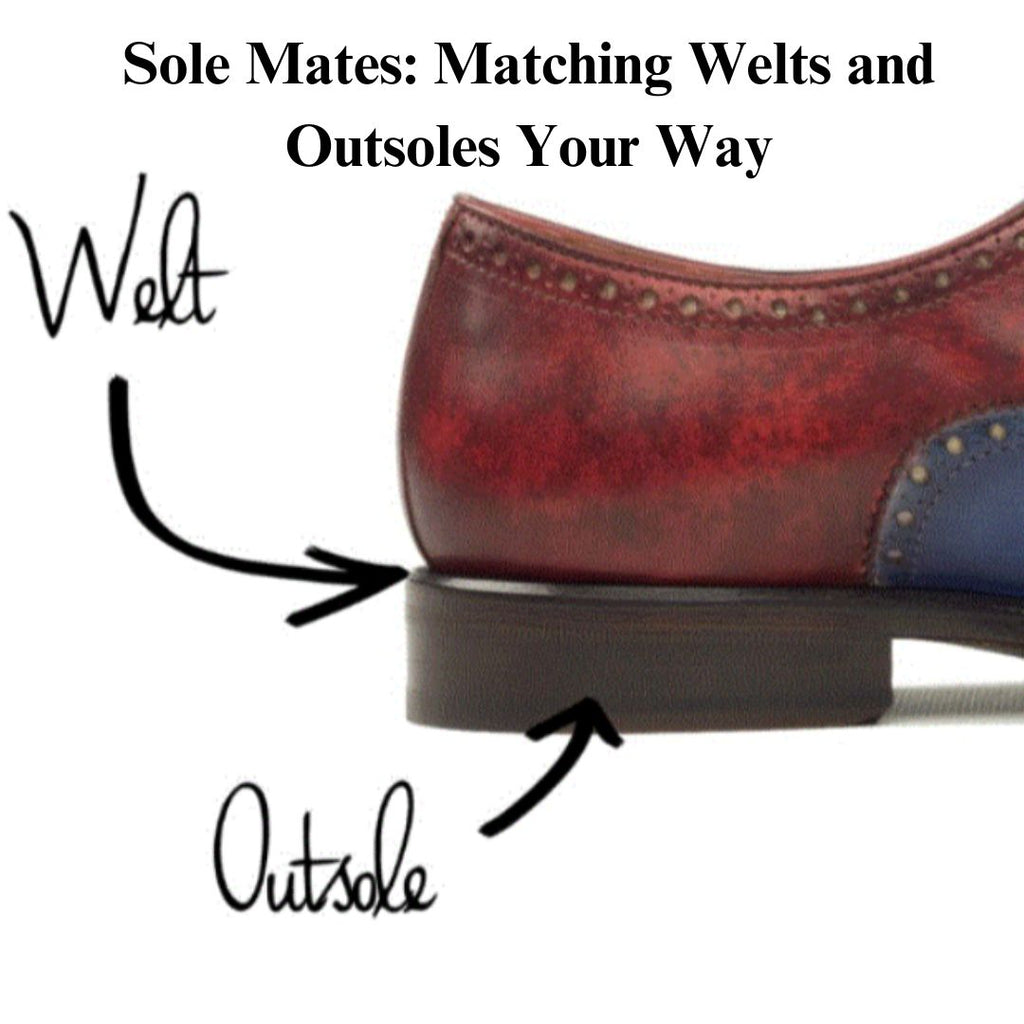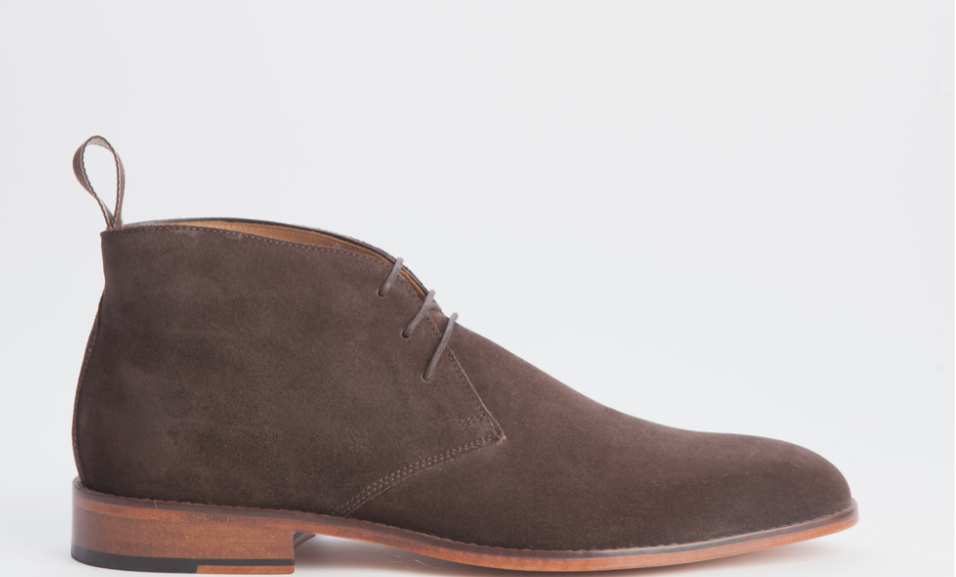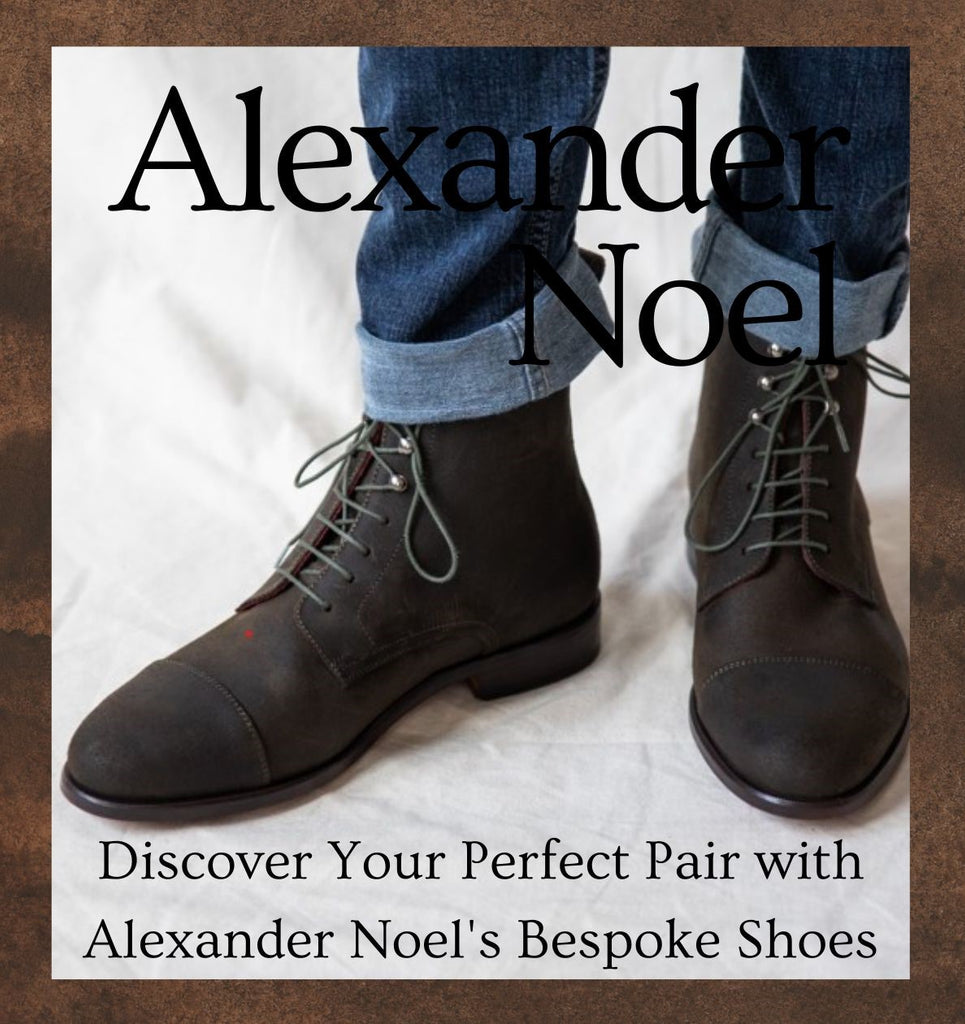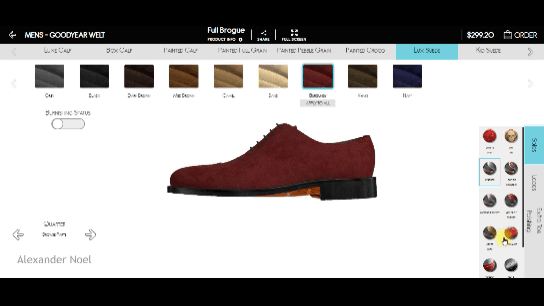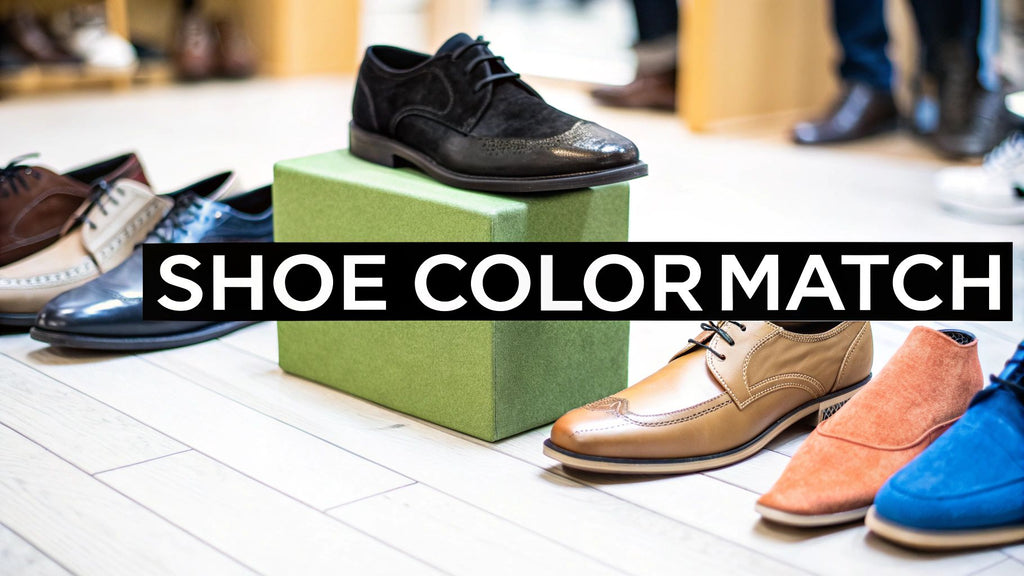
Your Essential Shoe Color Matching Guide

Welcome to our definitive shoe color matching guide. This isn't about memorizing outdated rules, but about developing an intuitive feel for what works, so you can step out with confidence every single time. Think of it as the secret to making your artisan-crafted shoes the perfect anchor for your look—or a powerful statement piece.
Building Your Foundation in Shoe Color
A truly great outfit tells a story, and your shoes? They’re the final punctuation mark. Nailing the color is less about rigid science and more about a well-practiced art.
Forget everything you’ve heard about strict formulas. The real goal here is to build an intuitive sense for color, allowing your own personal style and the quality of your footwear to take center stage. This is where our educational approach to footwear comes in: understanding the why behind color pairings empowers you to make better choices, whether you're styling a pair you already own or creating a brand new one in our Design Lab.
It's simpler than you might imagine. By focusing on just a few core concepts, you can build a versatile shoe collection that works seamlessly with your entire wardrobe. You'll start seeing your shoes not just as a finishing touch, but as a core part of your style.
Why Shoe Color Matters More Than You Think
The color of your shoes can completely change how your entire outfit is perceived. It has the power to dress a formal suit down or make a casual look feel instantly more polished. It's that subtle nod that signals you pay attention to the details—the kind of detail our global artisan partners obsess over.
Here’s what your shoe color choice is really doing:
- Setting the Formality: A black shoe is always going to feel more formal than a brown one. A light tan loafer is naturally more relaxed than a deep oxblood derby. The color sets the tone before anything else.
- Creating Visual Harmony: When colors complement each other, it creates a smooth, unbroken line from head to toe. This results in a look that feels intentional and put-together.
- Expressing Personality: A sudden pop of color can be a fantastic way to show off who you are, while classic, time-tested pairings convey a quiet, timeless sophistication.
A thoughtfully chosen shoe color does more than just match your trousers; it harmonizes with the occasion, reflects your personality, and honors the craftsmanship of the shoe itself. It’s the ultimate expression of deliberate style.
The Modern Approach to Color Rules
Let's be honest: traditional style advice like the old "no brown in town" rule is completely obsolete. Today's style is all about flexibility, context, and personal expression. It’s liberating, and it opens up a world of creativity in your daily wardrobe.
Instead of trying to memorize a long list of dos and don'ts, it's far more effective to focus on a few guiding principles. This is the mindset we champion—empowering you with the knowledge to become your own style expert. The idea is to build a reliable foundation you can lean on, whether you're dressing for a critical business meeting or a laid-back weekend brunch. In the same way selecting the right shoe color is crucial, so is applying expert tips on choosing accessories for a perfect fit and style to elevate your entire look.
Ultimately, this guide is here to give you the tools to build that confidence. Once you understand the interplay of color, you can make every single pair of shoes—especially those you design yourself—work that much harder for you. This journey starts with understanding, not rules.
Putting Color Theory to Work in Your Wardrobe
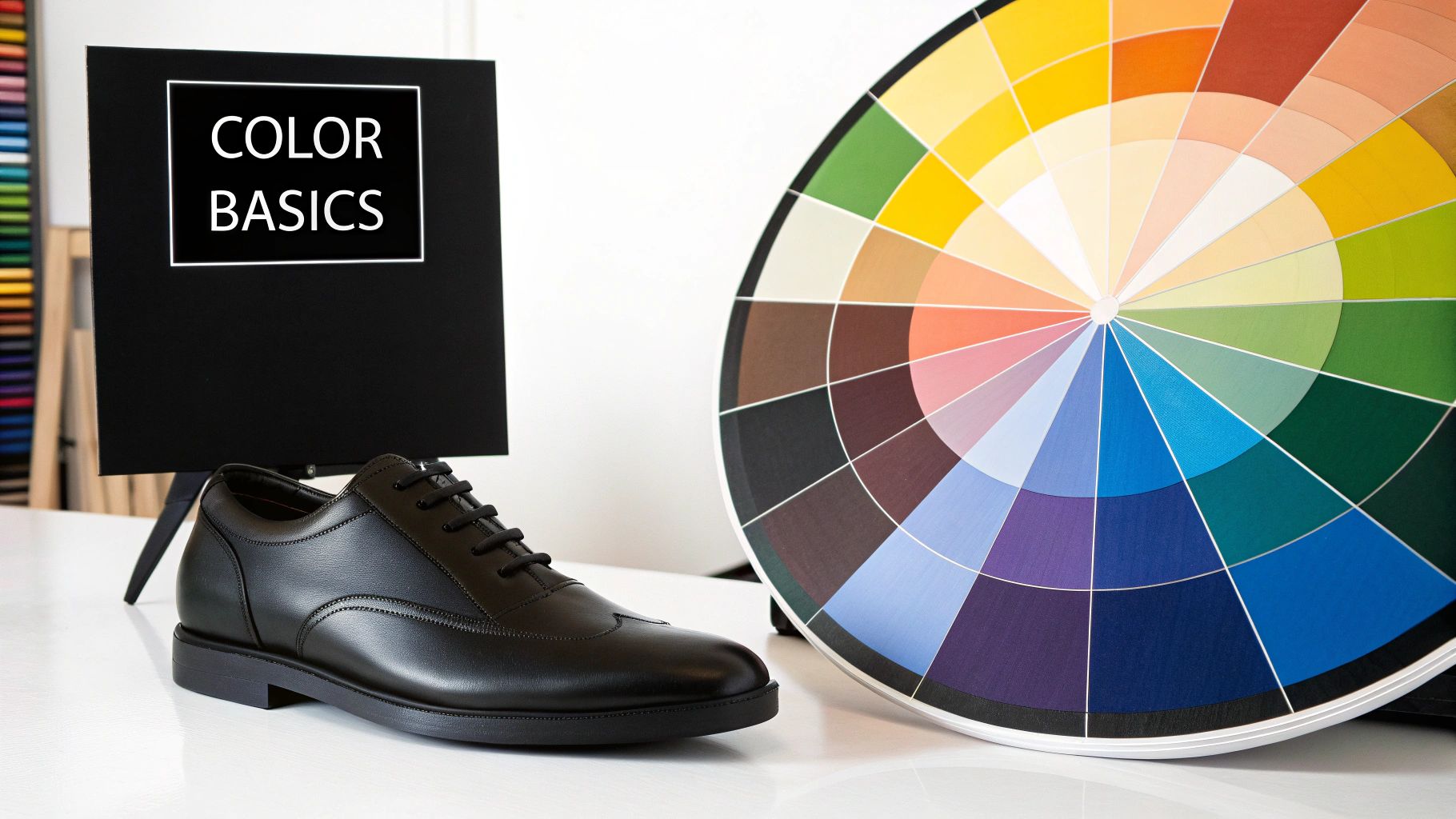
Let's bring color theory off the page and into your closet. This isn't about memorizing abstract rules; it's about developing an eye for what works. Once you start seeing color like a stylist, you gain the confidence to move beyond the "safe" choices and start making truly inspired ones, starting from the ground up.
The key ideas are actually quite simple. Hue is just the color itself (like red, blue, or green). Saturation is its intensity—think a vibrant, pure red versus a more muted, dusty rose. Value is simply how light or dark that color is.
Where this gets interesting is when you see these principles play out across different materials—a concept central to our blend of traditional craftsmanship and modern innovation. An oxblood calfskin leather has a deep value and rich saturation, giving it a formal, commanding presence. But take that same oxblood hue and apply it to suede, and the story changes. The soft, textured surface absorbs light, lowering the value and saturation. The result? A shoe that feels more relaxed, approachable, and casual.
The Psychology of Your Shoe Color
Every color you wear sends a quiet signal, and your shoes are no exception. This isn't just theory; it's a powerful way to shape how you're perceived, whether you're in the office or out on the town.
Take the classic brown dress shoe. A deep chocolate brown suggests reliability and stability—it's grounded and serious, but still approachable. A lighter tan, however, feels more open, casual, and friendly. It’s the color of a weekend road trip, not a critical boardroom meeting.
Now, let's look at some bolder choices:
- Burgundy or Oxblood: These shades signal quiet confidence and a bit of creative flair without shouting. They’re a brilliant way to stand out in a sophisticated manner.
- Navy Blue: Often seen as trustworthy and composed, a navy suede loafer is a fantastic, modern alternative to black or brown for any smart-casual look.
- Olive Green: This color brings a sense of ruggedness and practicality to the table, making it a natural fit for boots or casual sneakers.
Your choice of shoe color is a non-verbal cue that speaks volumes. By understanding what different colors communicate, you can select or design footwear that not only completes your outfit but also reinforces the exact impression you want to make.
Finding Harmony (or Making a Statement)
Once you've got a feel for color, you can start building pairings that either create a seamless, harmonious look or a bold, high-contrast statement. There's a time and place for both—it all comes down to the occasion and your personal style.
Harmonious pairings lean on colors that are neighbors on the color wheel. This creates a cohesive, polished look that just feels right. For instance, a navy suit paired with deep burgundy shoes works beautifully because blue and red are close. It creates a rich, sophisticated look that’s easy on the eyes.
This isn’t just our opinion. A study on shoe customization from Ohio State University found that people consistently prefer designs using a tight palette of related colors. If one part of the shoe was reddish, they were more likely to pick other warm tones. It shows our natural preference for harmony.
High-contrast pairings, on the other hand, are all about energy. By using colors from opposite sides of the wheel, you create a look that pops. Think of the sharp, modern confidence of tan shoes against a pair of crisp navy trousers. For more ideas on bold combinations, keep an eye on our guide to men's shoe color trends for 2024.
This knowledge is the perfect launchpad for you to start experimenting in our Design Lab, where you can take these principles of customization and apply them directly to a custom-made shoe that is 100% you.
A Practical Guide To Pairing Shoe Colors With Outfits
Theory is great, but putting it into practice is what separates a good outfit from a great one. This is your playbook for getting it right. We'll move beyond the basics and get into real-world advice for pairing your artisan-made shoes with everything from classic suits and smart-casual chinos to weekend denim.
So, what color shoes should you wear with those navy trousers? How do you style a unique pair in olive green? Let's get into it. The goal here isn't just to give you rules but to build your confidence so you can start making these choices instinctively.
The Core Three Trouser Colors
Most men's wardrobes are built around a few foundational trouser colors. If you can nail the pairings for these, you're set for almost any occasion. We're talking about the big three: navy, grey, and tan/khaki.
Pairing with Navy Trousers: Navy is a classic for a reason—it's an incredibly versatile anchor for any look. For that sharp, professional vibe, you honestly can't beat dark brown or oxblood shoes. The warmth of the leather creates a rich, sophisticated contrast against the cool blue of the trousers. Black shoes are a safe, formal bet, but sometimes they can feel a little too stark.
Want a more modern, high-contrast look? Try tan or light brown shoes, especially in a smart-casual setting. It's a confident move that really pops.
Styling Grey Trousers: Grey is a true chameleon. It's a neutral canvas that lets your shoes do the talking. With light grey trousers, you have plenty of options—black, dark brown, and oxblood all look fantastic. For a darker charcoal grey, black shoes create a sleek, formal silhouette. If you want a bit more personality, oxblood/burgundy adds a subtle, sophisticated splash of color.
A word of caution with brown shoes and grey trousers: pay close attention to the shades. You want a clean contrast, not a combination that just looks muddy.
Working with Tan or Khaki Trousers: These earthy, warmer tones are naturally more relaxed. They pair beautifully with nearly any shade of brown, from a deep, dark espresso to a lighter tan. This is where you can really play with textures, too—think suede loafers or burnished leather.
For something a bit different, burgundy or even navy shoes can create a really stylish, interesting look. The one color to steer clear of? Black. The contrast is usually too harsh and clashes with the laid-back feel of the trousers.
This visual guide is a perfect illustration of how a core collection of neutral-toned shoes gives you maximum versatility.
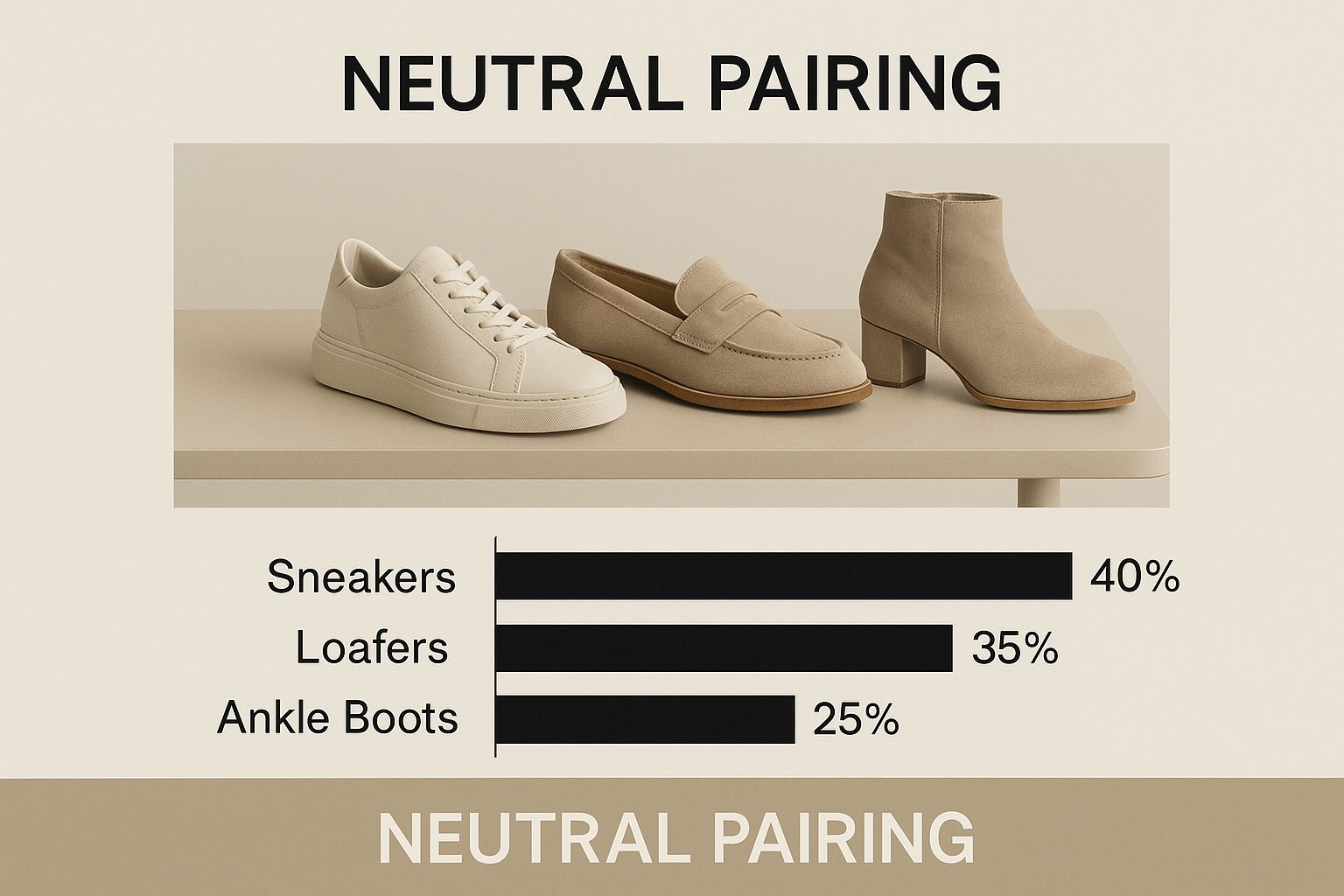
As you can see, getting these foundational pairings right unlocks countless outfit combinations across your entire wardrobe.
For a quick reference, I've put together this simple table. It's a great cheat sheet for those moments when you're standing in front of your closet and need a quick, reliable answer.
Essential Trouser and Shoe Color Pairings
| Trouser Color | Black Shoe | Dark Brown Shoe | Tan/Light Brown Shoe | Oxblood/Burgundy Shoe | Style Note |
|---|---|---|---|---|---|
| Navy | Formal, safe | Versatile, classic | Modern, high-contrast | Sophisticated | Dark brown is arguably the most versatile pairing for navy. |
| Grey | Formal (esp. with charcoal) | Classic | Works with lighter grey | Stylish, adds color | Black for business, oxblood for a touch of personality. |
| Tan/Khaki | Avoid | Excellent, classic | Excellent, casual | Stylish, unique | Stick to shades of brown or burgundy for the best look. |
| Olive | Can work | Great, earthy feel | Great, rugged | Unique contrast | Brown and tan are the safest and most stylish bets here. |
| Black | Classic, monochrome | Too casual | Too casual | Bold statement | Keep it simple: black on black is timeless. |
This table covers the most common scenarios you'll encounter, giving you a solid starting point for building any outfit, whether you're aiming for a formal, business casual, or relaxed weekend look.
Beyond The Basics: Styling Unique Colors
Ready to step outside the world of brown and black? Venturing into more distinctive colors like olive green, navy, or even grey opens up a whole new world of style. Think of these as "colored neutrals"—they're surprisingly easy to wear.
- Olive Green Shoes: These look incredible with other earthy tones like tan, brown, and beige. They also bring a rugged-yet-refined feel when paired with navy trousers or dark denim.
- Navy Blue Shoes: A fantastic and modern alternative to the usual suspects. Try them with grey, tan, or even burgundy trousers for a subtle and incredibly stylish combination.
- Grey Suede Shoes: A pair of grey suede loafers or sneakers can completely change the game. They pair effortlessly with black, navy, or white trousers for a clean, minimalist aesthetic.
The real secret to pulling off unique shoe colors is to let them be the star. Keep the rest of your outfit relatively simple and let your footwear—a true testament to artisan craftsmanship—command the attention.
From Custom Design To Perfect Pairing
This is where the magic really happens. We've seen a huge shift in men's style; guys no longer want off-the-rack solutions. The global custom shoes market hit USD 779.58 million and is expected to soar to USD 1,198.09 million by 2033. It's clear that men, especially in North America which holds over 55% of the market, want footwear that reflects their personal style.
Our Design Lab was built for this exact purpose. It puts our focus on customization at your fingertips, allowing you to go beyond just matching what's available and instead create the perfect shoe from scratch.
Imagine you have a pair of olive green chinos you love but can never quite figure out how to style. Instead of endlessly searching for a shoe that might work, you can jump into our interactive designer. You could create the perfect companion—maybe a pair of rich, dark brown leather sneakers or some elegant tan suede loafers, dialing in the exact shade and material that will make those trousers sing.
This completely flips the script. The shoe color matching guide goes from being a reactive tool to a proactive design process. You can apply the same thinking when blending style and comfort with the perfect dress sneakers. This approach ensures that every pair of shoes you own isn't just an afterthought, but a deliberate and integral part of your personal style.
Choosing the Right Shoe Color for Different Occasions
A pair of artisan-crafted shoes can absolutely make an outfit, but their real magic is unleashed when the color is a perfect match for the occasion. Knowing how to pick the right shade for a specific setting is what separates a good look from a truly memorable one. It's about so much more than just matching colors; it’s about sending the right message.
This isn't about following stuffy, old-school rules. Think of it as a practical guide for modern life. After all, a high-stakes business meeting requires a totally different feel than a casual brunch, and a sunny summer wedding has a different vibe than a cozy autumn get-together.
Decoding the Dress Code: Formal vs. Casual
The first thing I always consider is the formality of the event. It’s the biggest clue for your shoe color palette. For those buttoned-up, highly formal settings, your color choices will naturally become more focused.
- Formal Occasions: When it comes to business meetings, conservative office environments, or black-tie affairs, black is still the undisputed king. It just projects seriousness and professionalism. Dark brown or a deep, rich oxblood are also fantastic choices, adding a touch of sophisticated personality without straying too far from tradition.
- Smart-Casual and Relaxed Events: This is where you really get to play and let your personal style shine. For things like casual Fridays, weekend brunches, or relaxed evening parties, the world of color opens right up. Lighter browns, tans, and even a deep navy suede become excellent options that say "relaxed, but still sharp."
The trick is using color to show you understand the tone of the event. A sleek black oxford speaks a formal language, while a tan suede loafer communicates an easy, effortless style.
Your shoe color is a subtle cue that shows you're stylistically and socially aware. Picking a dark, polished leather for a formal event signals respect for the occasion. On the other hand, opting for a lighter, more textured shoe for a casual gathering shows you know how to relax in style.
Navigating Seasonal Palettes
Just like your clothes change with the seasons, your shoe color palette should, too. The light and atmosphere of different times of the year just feel right with certain tones. When your footwear is in harmony with the season, your whole look feels more intentional and put-together.
Spring and Summer Style When the days get longer and warmer, your shoes should reflect that sense of lightness.
- Lighter Tones: I'm talking about tan, beige, light grey, and even a crisp white. These colors are the perfect complement to lighter summer fabrics like linen and cotton and feel right at home at outdoor events.
- Casual Materials: This is the ideal time to break out the suede or nubuck. Their softer textures pair beautifully with the relaxed feeling of the season.
Autumn and Winter Foundations As the weather cools and the light softens, it's time to ground your outfits with richer, deeper colors.
- Deeper Shades: Fully embrace the warmth of oxblood, dark chocolate brown, and rich navy suede. These colors have a certain depth and weight that work so well with heavier fabrics like wool, flannel, and tweed.
- Polished Finishes: A polished leather in these deep shades adds a touch of refinement that holds its own during more formal winter events and holiday parties. When thinking about footwear for the colder months, you might also find some great ideas in The Essential Guide to Women's Boots, which dives into both style and practicality.
When you're dressing for a truly special event like a wedding, your color choice is even more important. You want a shoe that complements your outfit without stealing the show. For some great, context-specific advice on this, check out this article on ideal shoe color choices for weddings. It’s a perfect example of how the right guidance can make all the difference.
Mastering Advanced Color Coordination
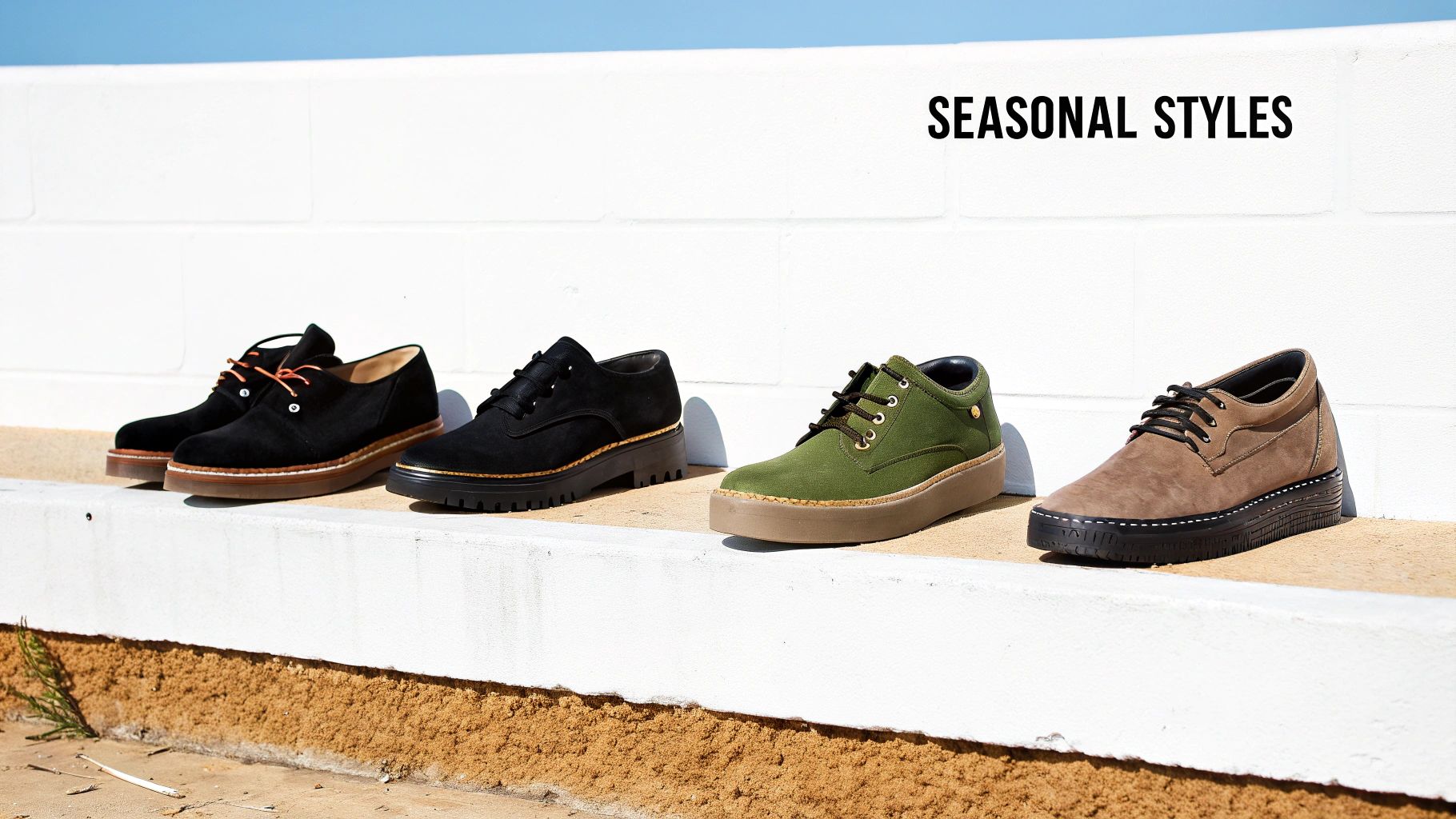
Once you’ve got the basics down, it’s time to play. This is where your personal style really begins to take shape, moving beyond simple shoe-and-trouser pairings into truly thoughtful outfits. It’s about creating a look that’s cohesive, intentional, and feels uniquely you.
These are the techniques that elevate a great pair of shoes into a signature part of your wardrobe. Let's dive into how you can use monochromatic looks, strategic color pops, and accessory harmony to build an ensemble that shows true craftsmanship and confidence.
The Power of Monochromatic Looks
A monochromatic outfit—built from different shades and tints of one color—is one of the sharpest ways to create a sleek, sophisticated silhouette. It's a confident move that looks incredibly chic when you get it right.
Forget just all-black. Picture a palette of blues: dark navy trousers, a sky-blue shirt, and a pair of rich, deep navy suede loafers to ground it all. The secret is to play with both texture and value (the lightness or darkness of the color). A polished leather catches the light differently than soft suede or a woven fabric, which adds visual depth and stops the outfit from looking one-note.
This approach takes a bit of a discerning eye, but it’s a powerful way to create a memorable look. As you build your collection, you can find more inspiration in The Ultimate Guide to Stylish and Versatile Men's Footwear, which explores different styles that are perfect for monochromatic outfits.
Using a Strategic Pop of Color
Sometimes, an outfit just needs a shot of energy. A "pop of color" is a classic style move, but the secret is in the execution. You want it to look deliberate, not like you got dressed in the dark. Your shoes are the perfect way to do this, offering a confident accent that anchors your whole look.
Here's how to pull it off with finesse:
- Keep the Canvas Neutral: A vibrant shoe really sings against a quiet background. Think of deep green loafers paired with a simple khaki and white outfit, or rich burgundy boots with dark wash denim and a grey sweater.
- Echo the Color Subtly: To make the pop feel intentional, tie the shoe color into a small detail elsewhere. It could be a fleck of color in your pocket square's pattern, the face of your watch, or a subtle stripe in your socks.
The most effective pop of color feels like a confident choice, not an accident. It draws the eye in a controlled way, showing that you’ve considered every detail of your outfit, right down to the ground.
This is where having access to our Design Lab becomes a game-changer. Instead of hunting for the perfect shade, you create it yourself. You can design a shoe in the exact cobalt blue or emerald green you envisioned, making sure your statement piece is genuinely one-of-a-kind.
Harmonizing Shoes with Accessories
The final level of style mastery is creating a clear sense of harmony between your shoes and your other leather goods. Matching your shoes to your belt, watch strap, and even the trim on a briefcase creates a visual thread that signals impeccable attention to detail.
This doesn't mean everything has to be a carbon copy. A dark brown shoe can pair beautifully with a medium brown belt, as long as they share the same warm or cool undertones. The goal is coordination, not cloning.
This holistic view is at the heart of the bespoke experience. When our artisans craft a pair of shoes, they’re thinking about how that specific leather and color will fit into a client's entire wardrobe. It's what turns a product into a true personal style asset. The demand for this level of personalization is growing rapidly, with the custom sneakers market alone projected to hit USD 2.82 billion. This growth is fueled by people who want footwear that perfectly reflects their style—a trend particularly strong in North America, which holds 55% of the market share. This desire for personalization reinforces the value of building a versatile collection around a few key colors, ensuring you always have a perfectly harmonized option ready to go.
Common Shoe Color Questions Answered
Even when you've got a good handle on color theory, specific questions always come up. We get it. Real-world style isn't just about rules; it's about navigating those tricky situations that pop up when you're getting dressed. This is where we tackle the most common dilemmas we hear about matching shoe colors.
Think of this as your go-to reference for making confident style decisions. We believe that an educational approach to footwear is what empowers you to build a wardrobe that feels truly your own—especially when you have the ability to design your own shoes from the ground up.
Can I Wear Black Shoes With Brown Trousers?
This is a classic style question, and while tradition might have called it a mistake, the modern answer is yes—when it’s done right. You're not looking for a muddy, accidental pairing. You want clean, intentional contrast.
A sharp, sleek black leather shoe, for example, can look fantastic against a pair of lighter tan or khaki chinos. It feels purposeful. Where you want to be careful is pairing formal black dress shoes with dark brown suit trousers; that combination almost always looks mismatched.
And what about the belt? The old advice still holds true here. Matching your belt to your shoes is the quickest way to look polished and put-together, especially in a business or formal setting.
What Are The Most Versatile Shoe Colors?
If you want a truly versatile shoe collection that has you covered for almost any outfit or occasion, there are three core colors that every man should own. Having these in your rotation means you're ready for anything.
- Dark Brown: A rich chocolate or espresso is the ultimate workhorse. It looks just as good with navy and grey suits as it does with denim and chinos.
- Tan or Light Brown: This is your MVP for smart-casual. A medium or light brown shoe is perfect for lighter suits, pretty much any shade of chino, and is an absolute essential for warmer weather.
- Oxblood or Burgundy: Think of this as the sophisticated alternative to brown. It's incredibly versatile, pairing with almost as many colors, but it adds a shot of personality and depth that brown sometimes lacks.
While a great pair of black shoes is non-negotiable for formal events, these three colors will give you far more mileage day-to-day.
How Does Shoe Material Affect Color Matching?
This is a detail that separates the novices from the experts. The material of a shoe completely changes how a color is perceived and, by extension, how formal it feels. A color isn't just a color; its texture gives it character.
Take brown suede, for instance. It has a soft, muted finish that absorbs light, which automatically makes it feel more relaxed and casual.
Now, picture that same shade of brown on polished calfskin leather. It reflects light, creating a sharper, more commanding presence that’s undeniably more formal. Our blend of traditional craftsmanship and modern innovation means we appreciate this nuance. When you're putting an outfit together, you have to consider both the color and the texture.
A suede loafer might be the perfect partner for your favorite denim, but a polished leather oxford in the very same color is destined for tailored trousers or a suit. Mastering this interplay between color and material is what really elevates your personal style.
At Alexander Noel, we put the power of choice directly in your hands. Instead of searching for the perfect shoe, our Design Lab lets you create it. Choose the exact shade, material, and style to build a truly custom pair that perfectly complements your wardrobe and personal style.


